Innisfil, Ontario, Canada
Architect: Tom McBroom (1990)
7,013 Yards, Par-72
Rating/Slope: 74.0/148
My Quick Review: Among the most underrated courses in Canada, with a very good set of greens, ground-game options and tremendous par-4 and par-5 variety.

A few thoughts...
1) This is one of McBroom's earliest designs, built in his 'wild green' era. Though same may say this is a negative, I think it is a big part of what makes National Pines as good as it is. There is tremendous variety in his greens. Everything from diagonal ridges (1, 3, 10, 11) to regular ridges (5) to tilted (6, 12) to spines and ridges (2) to potato-chipped (8, 15) to with bowls (4) to biarritzed (14) to with portions sloping away (1, 3, 17).
2) Many greens liediagonally to the lines of play, emphasizing a preferred angle of approach, though (sadly) mowing lines are an issue.
3) Every single par-4 and par-5 green will accept a running approach, though 3/4 of the par-3s will not.
4) Bunkering ranges from simple and strategic to oddly-placed and over-used.
5) Excellent variety in holes and shot demands, though the par-3s as a set are repetitive and clearly the weak point of the golf course. Though there are several short par-4s, there are non that are driveable. A problem easily remedied with the destruction of the back tee on 15.
All Yardages and Pictures from the 2nd from back Gold Tees (6,617 Yards, Par-72; 72.0/144)
Hole 1: Par 5, 497 Yards - The first is a gentle opener as long as the golfer can carry the bunker on the inside of the dogleg (220 yards). Plenty of width and a speed-slot await the golfer who successfully takes on the bunker, but woods left and right lurk. The bukers through the fairway on the right keep the bombers in check and receive little to no play.

Woods and a bunker pinch the fairway 100 yards out. Only if the golfer is out-of-position on the tee shot should laying-up to this area be a consideration.

The ideal line to approach this angled green is from the very far right over the fairway bunker. Unfortunately, there is no fairway there, but rough and trees are found.

The first of several greens with diagonal ridges at NP. Shots can easily be run onto the green, but one must play the shot carefully as the green runs away once over the spine

Hole 2: Par 4, 355 Yards -- A rather unappealing looking tee shot with water on the right and containment mounding and then the driving range on the left. The bunker is 255 yards to reach and is the aiming point for most. Though the Line of Instinct will tempt the golfer to try to carry the pond, it is 280+ yards and not an option for many. The pond does guard the ideal line.

The approach from the right side of the fairway can be run onto the green. From this angle the golfer need not carry the deep and imposing green side bunker.

As seen from behind, this is one of the most interesting greens I've seen. 2/3 the way back the green is split back-to-front by a ridge. The back 1/3 of the green tilts from the right and away from the tee. The first 2/3 of the green is split down the middle by a spine. The front-left portion of the green tilts back toward the golfer. The front-right portion, thanks in part to a knoll on the right edge of the green, forms a mini-bowl on the high-side of the spine. I know, a lot to take in, but it's a very cool green!

Hole 3: Par 4, 423 Yards -- Slicers beware, the 3rd and 4th are routed back-and-forth around the same hazard. Though the two holes are very similar on paper, the 3rd often plays downwind and the 4th into the wind making them feel very different.
Much of the fairway is hidden at the 3rd. Though many golfers will be tempted to thread the needle and play a driver over the edge of the hazard, I have found that the prudent play is a 220 yard shot toward the lone tree through the fairway.

Missing right is a lost ball. Missing left will put the golfer behind this single tree. Recoveries from here are possible, but not easy.

After a successful drive (or chip out) the approach from 150 yards looks like this. Reaching the 150 yard marker (and finding the centre of the fairway) is no easy feat and many golfers will face a more blind approach.
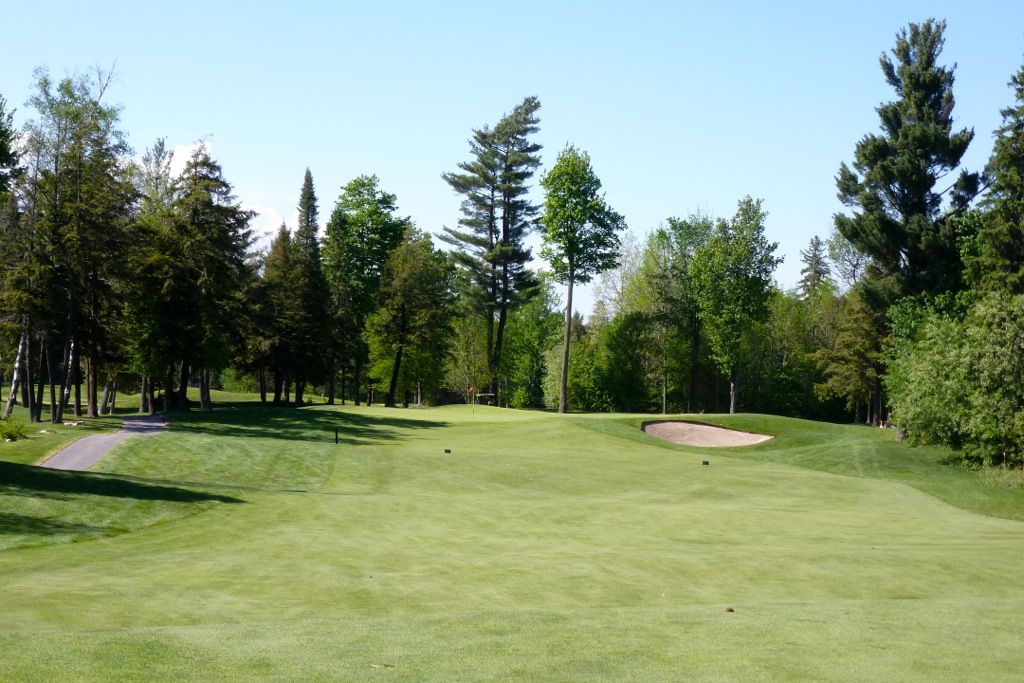
The 3rd green is another good one, laying at angle to the fairway. The front portion of the green is easily accessed from all angles and will accept a running shot. The small back portion of the green is very difficult to find. Not only is there a steep diagonal ridge in the green but there is also a duo of deep green side bunkers protecting a back-left pin. Pin it back there and this par 4.5 gets that much closer to playing like a par 5!
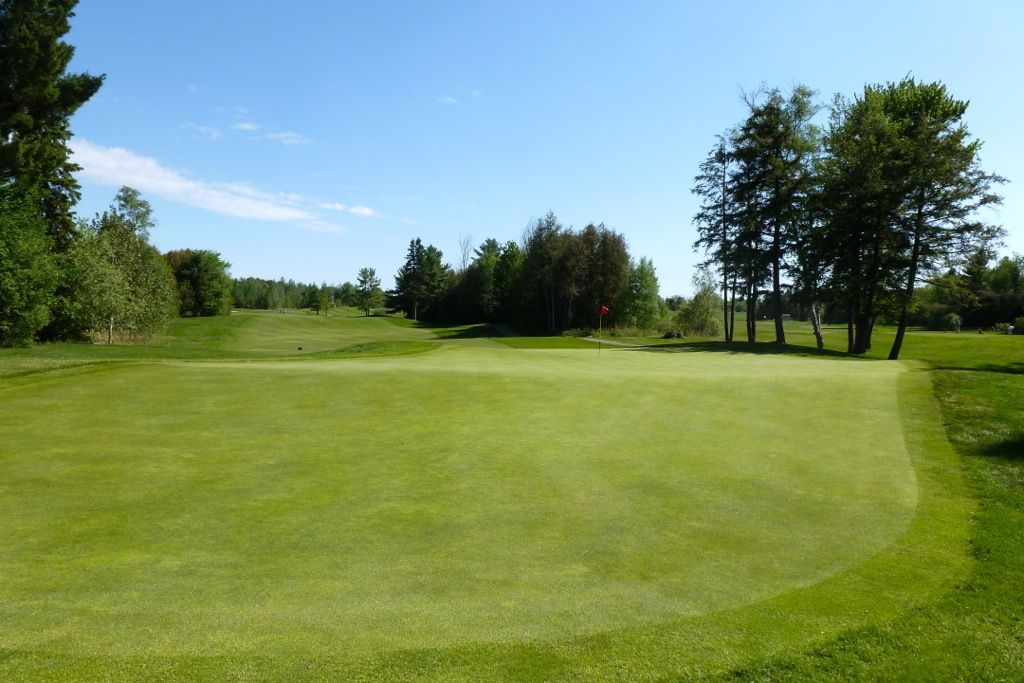
Hole 4: Par 4, 435 Yards -- From the gold tees it is just over 200 yards to reach the fairway on the shortest line, though it is considerably less than that just to clear the hazard. It is amazing how one is drawn to the Line of Instinct and will try to cut off as much as possible, especially in a case like this where there is little penalty for bailing out to the left.
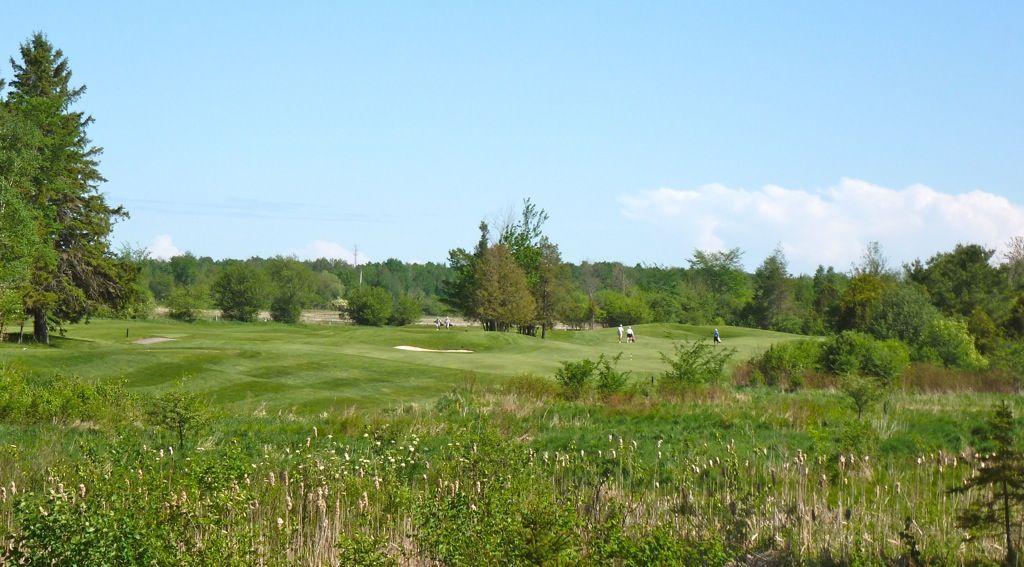
A look from just short of the fairway shows that the fairway is much wider than it appears from the tee and the golfer has acres of room to play left.

The approach as seen from 150 yards out. Though the hazard on the right looks out-of-play, a steep slope right of the green will kick slightly off-line approaches towards the trouble.
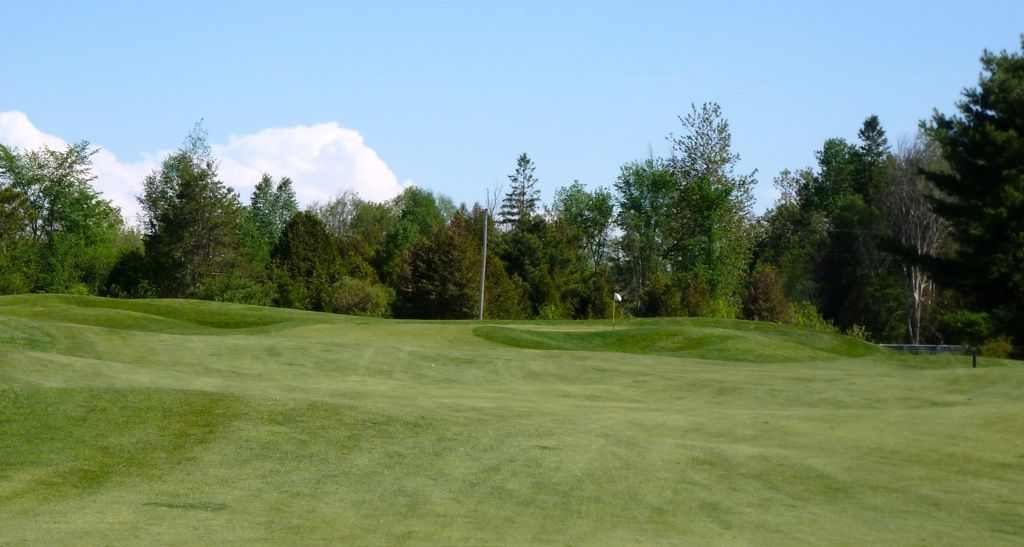
Perhaps in an attempt to help with playability on this brutal stretch of holes, McBroom chose to front the green with a grass bunker rather than a sand bunker. If you ask me, this hole needs no fronting hazard and an open green-front would have worked well here.
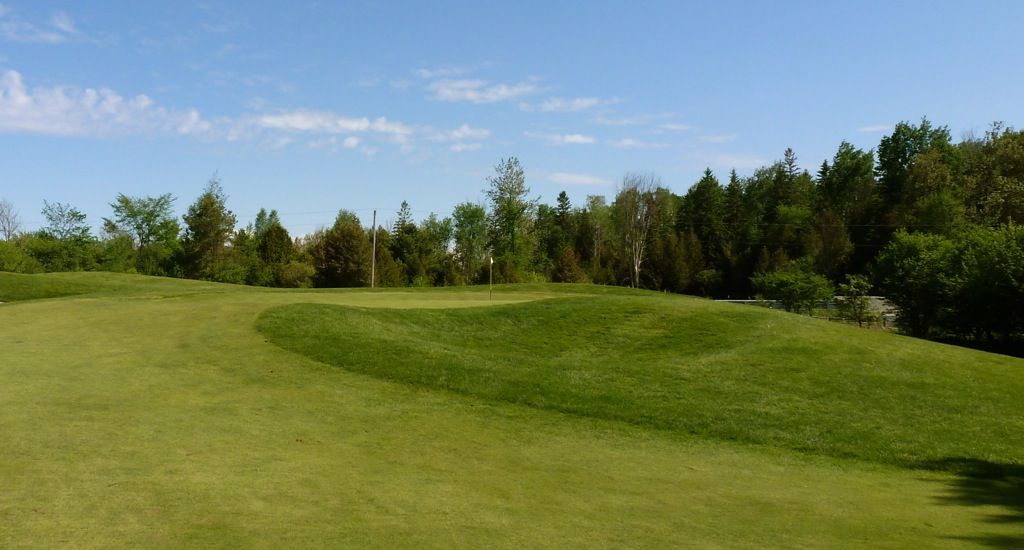
The green is long and somewhat narrow. The green is separated left and right by a spine down the centre and a slightly raised back-right portion of the green helps to form a bowl on the middle-right portion of the green.
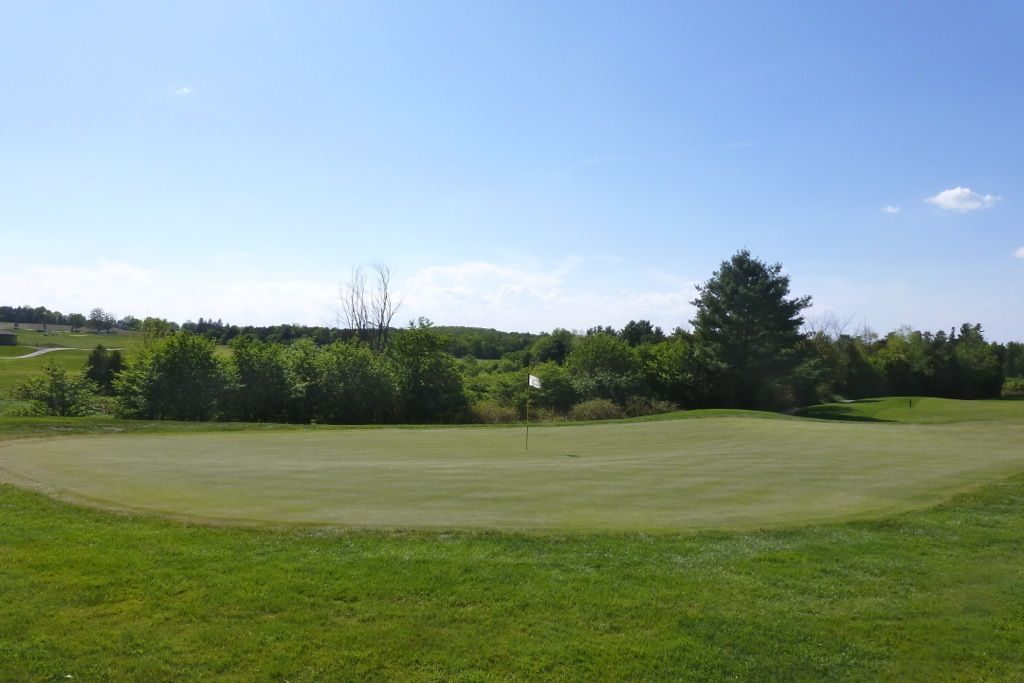 Hole 5: Par 4, 415 Yards -- The 3rd, 4th and 5th holes are routed back and forth and back again, with 3 and 5 often playing downwind. The ideal tee shot at the 5th will challenge the fairway bunkers on the right side of the fairway to leave the ideal angle of approach into this two-tiered green. Bunkers through the fairway on the left will catch bombers who are offline with their tee shot, though in practice I've never seen anyone in them.
Hole 5: Par 4, 415 Yards -- The 3rd, 4th and 5th holes are routed back and forth and back again, with 3 and 5 often playing downwind. The ideal tee shot at the 5th will challenge the fairway bunkers on the right side of the fairway to leave the ideal angle of approach into this two-tiered green. Bunkers through the fairway on the left will catch bombers who are offline with their tee shot, though in practice I've never seen anyone in them.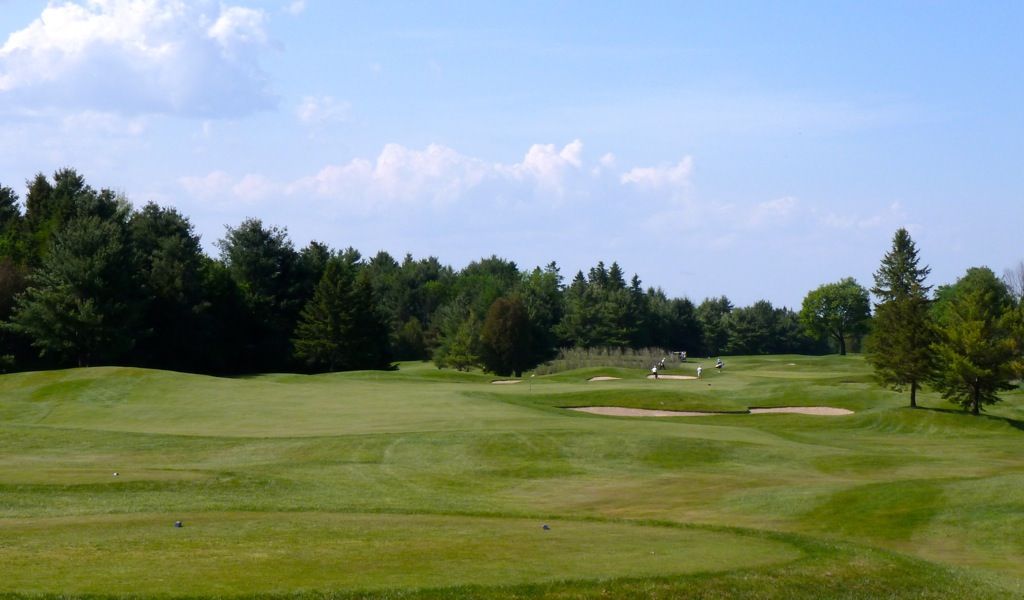
From the right side of the fairway the golfer has a clear look at the green and an open green-front to play to. The bunker on the right is, I suppose, a cross-bunker to add some level of decision-making for those wishing to play a running approach. I don't think it's necessary.
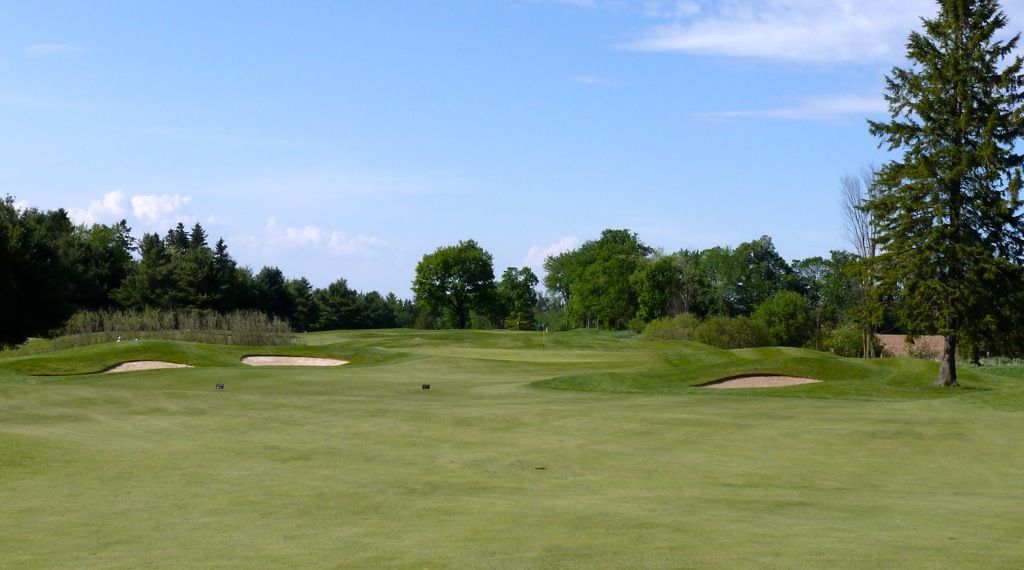
A simple green shape and tamely contoured, the 5th green tilts back toward the tee and is split across its centre by a ridge.


Hole 6: Par 3, 158 Yards -- Often playing with a cross-wind the 6th looks like an easy birdie but many will walk away shaking their head after making 5. The tee shot calls for an all-carry approach (as do 2/3 of the other par-3s at NP), though there is more room to miss short than there appears.
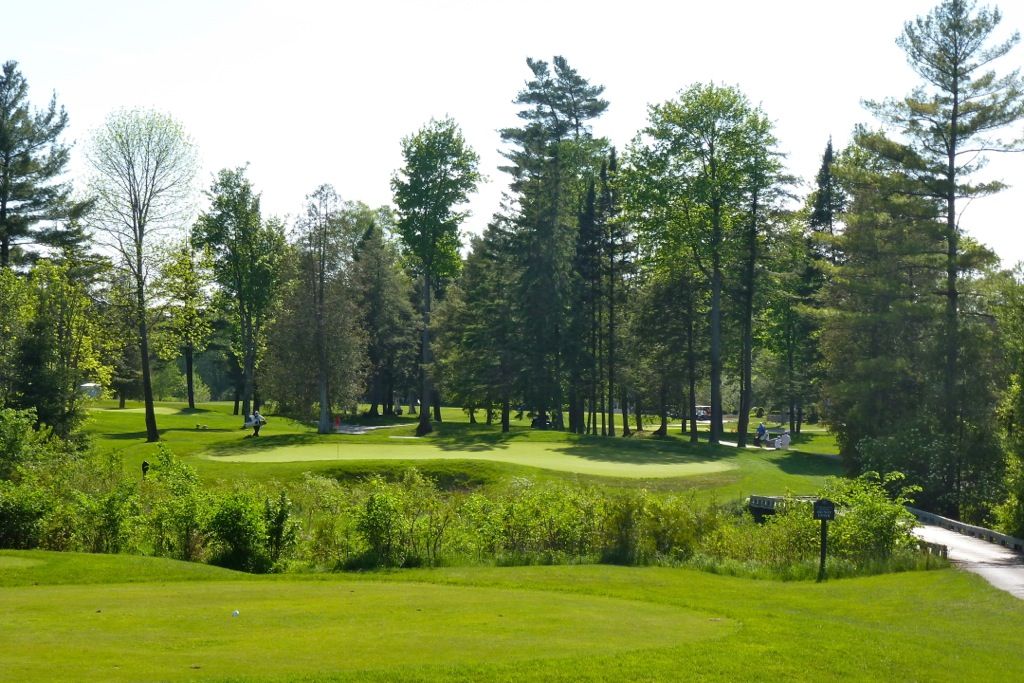
A deep fronting bunker will catch those that miss the green short. Though intimidating, it is better to find this bunker than to be long of the green.

The green is the most severely tilted on the course, sloping hard from back-to-front. Shots landing on the back 1/3 of the green will roll back all the way to the front of the green where, thankfully, there is some counterslope. Making things more difficult are a spine separating the green left and right, and a false-front on the right half of the green. Ping Pong is a possibility here.
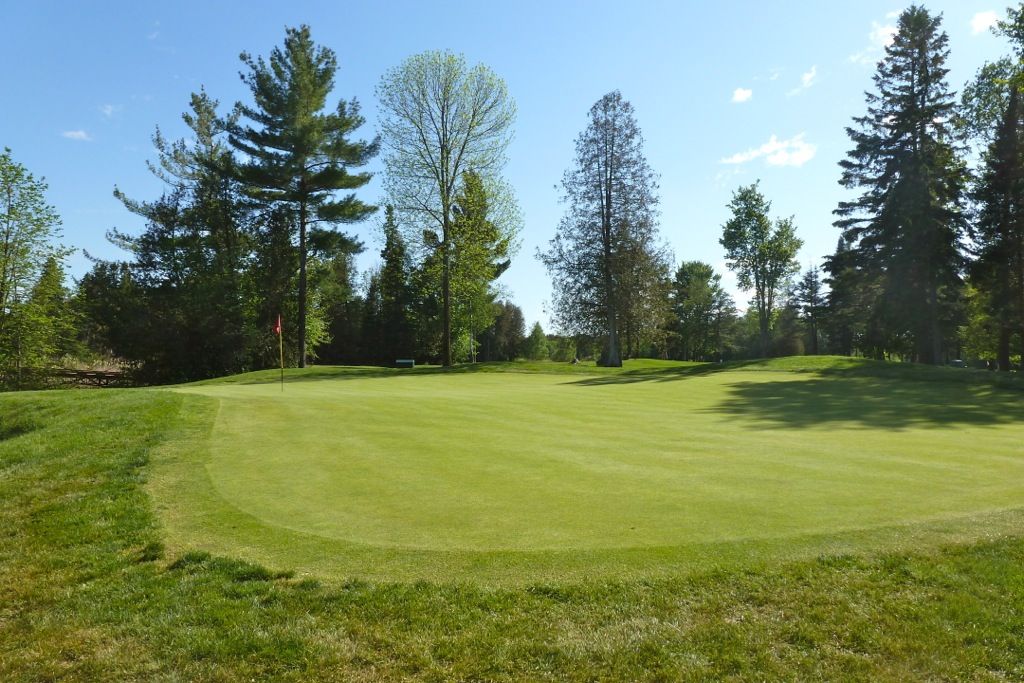
Hole 7: Par 4, 346 Yards -- The 7th is a decent short par-4, though it is not without fault. The aggressive tee shot is cleverly protected with a nest of bunkers that run along the diagonal fairway -- playing to the left edge of the fairway is a huge advantage as this angle provides easiest access to the green. Bunkers through the fairway will catch the longest of hitters, though they are nothing more than eye-candy for the majority of golfers.
I do wish that the fairway to the right/short of the bunkers were wider, providing an easier option for those not willing to take on the carry. As it lies, the 'lay-up tee shot' is just as demanding as the aggressive, thereby eliminating decision-making on the 7th tee.
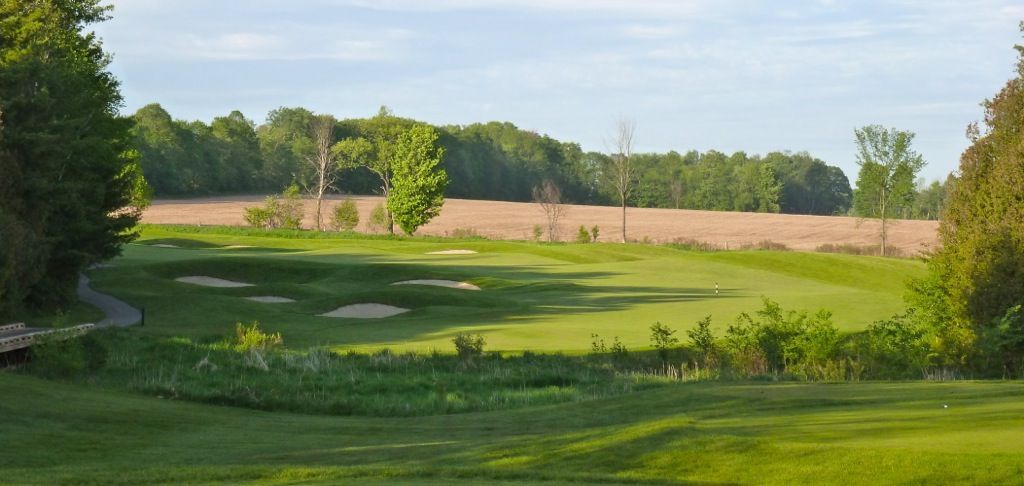
Though perhaps slightly overbunkered (the two short bunkers are nothing but penal), this nest of bunkers guard the ideal line.
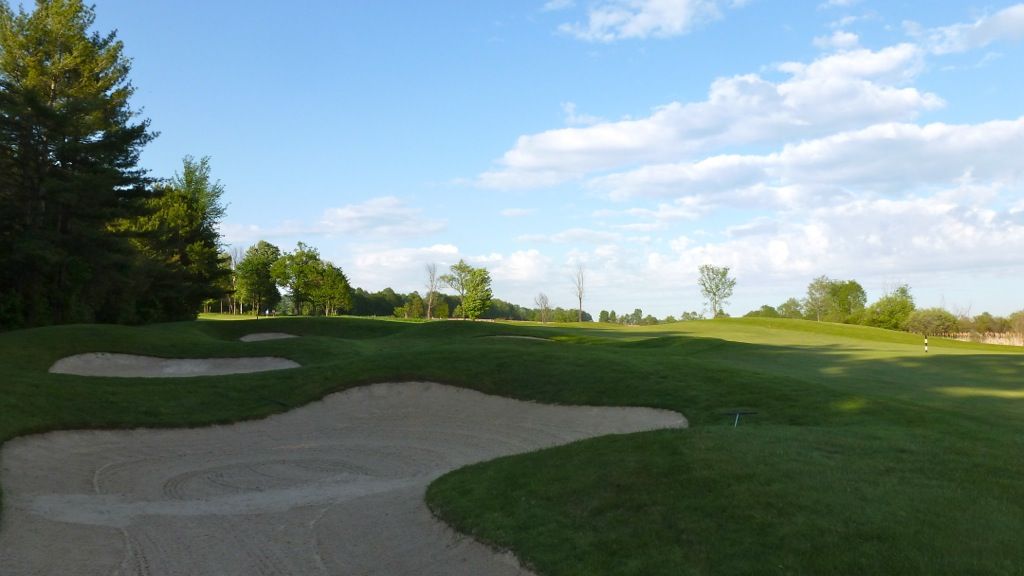
Approaching from the right (a bailed-out tee shot) is more difficult as the approach is played over a series of grass and sand bunkers to a putting surface that is largely obscured by mounding. Approaches from the left have a clear look at the green.

The front 3/4 of the green is tame, amongst the simplest on the course, with nothing more than a back-to-front tilt. But, a tiny (and seemingly often used) back portion of the green is very difficult to access as it is just over a large ridge and tilts away from the tee.
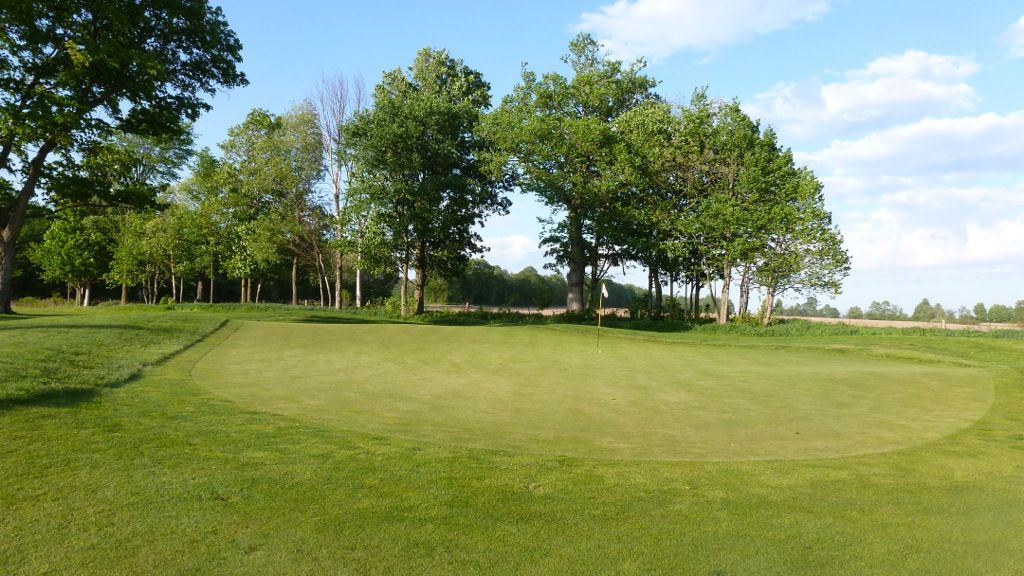
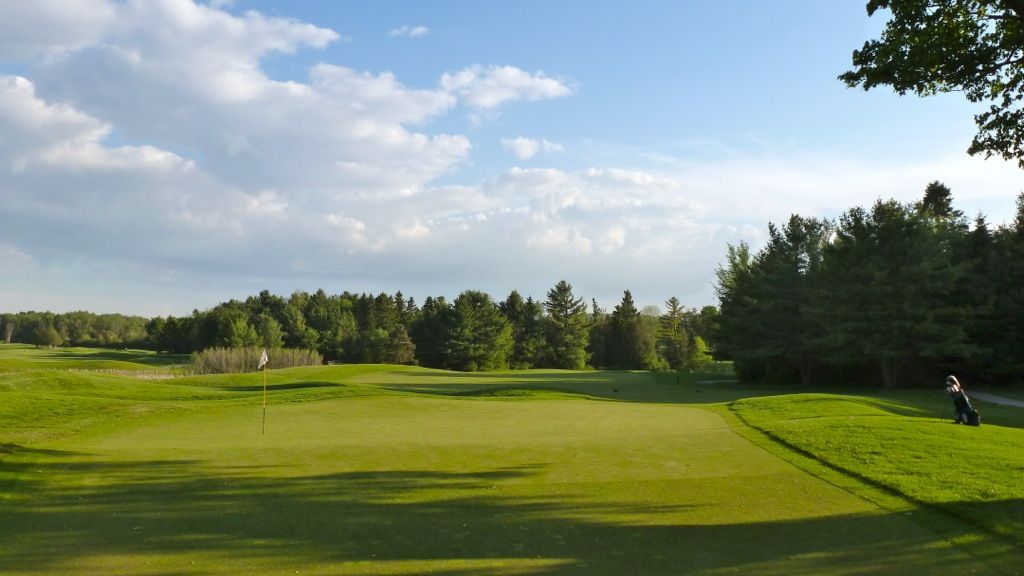
Hole 8: Par 3, 176 Yards -- Not exactly a memorable hole, but one that is often bogeyed nonetheless. Playing back into the wind, and with a very long and narrow green, this simple par-3 can play to well over 200 yards. McBroom placed the largest bunker on the course left of this green and as a result, one's sense of scale is affected and the narrow target made to feel even smaller.

This greens movements are more micro than the contours on most of the other greens, and the front half of the green is mostly flat. A very difficult to access back-left pin position is available though I'm not sure I've ever seen it used.


Hole 9: Par 5, 500 Yards -- The 9th is the first of back-to-back par-5s that are routed up and down the same terrain. 9 and 10 continue the stretch of breather holes that started at the 6th, but after the 10th there is little let-up all the way to the house!
The 9th tee shot is a demanding one, asking the golfer that wishes to hit driver to thread the needle, carrying the right bunker at 200 yards, playing right of the left bunker at 240 yards and left of the woods on the right. A cautious golfer can play toward the bunker on the left.
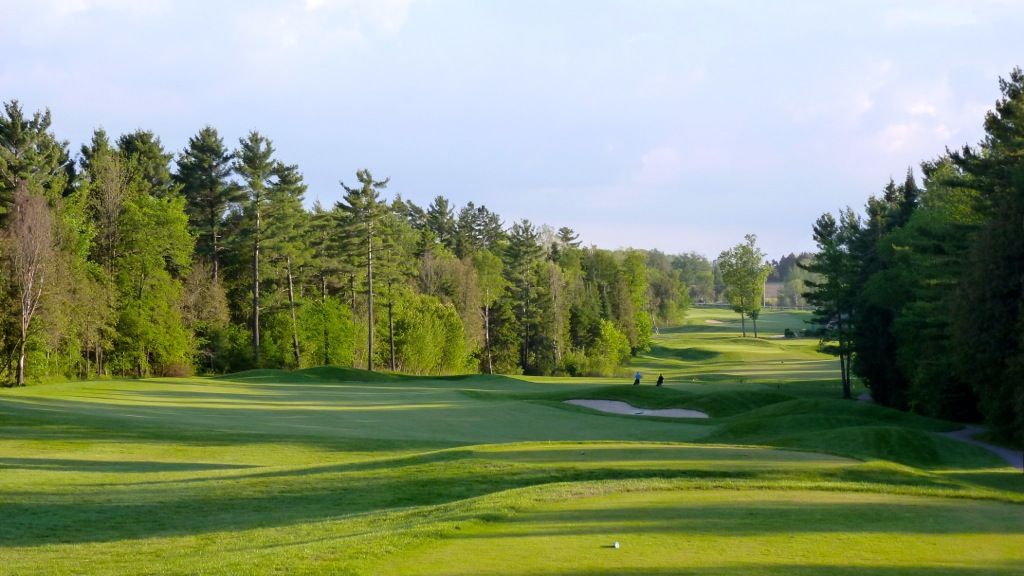
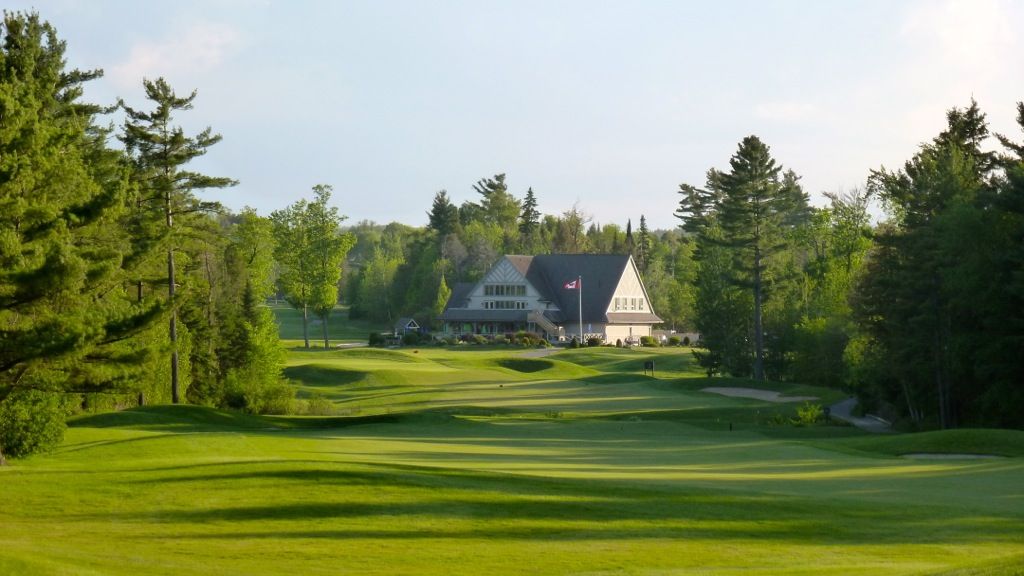
The 2nd shot at the 9th is a controversial one, requiring a demanding carry over wetlands. The wetlands start near the 150 yard marker and run 50 yards across at their shortest point. A 225 yard tee shot leaves a minimum carry of 175 yards over the wetlands.
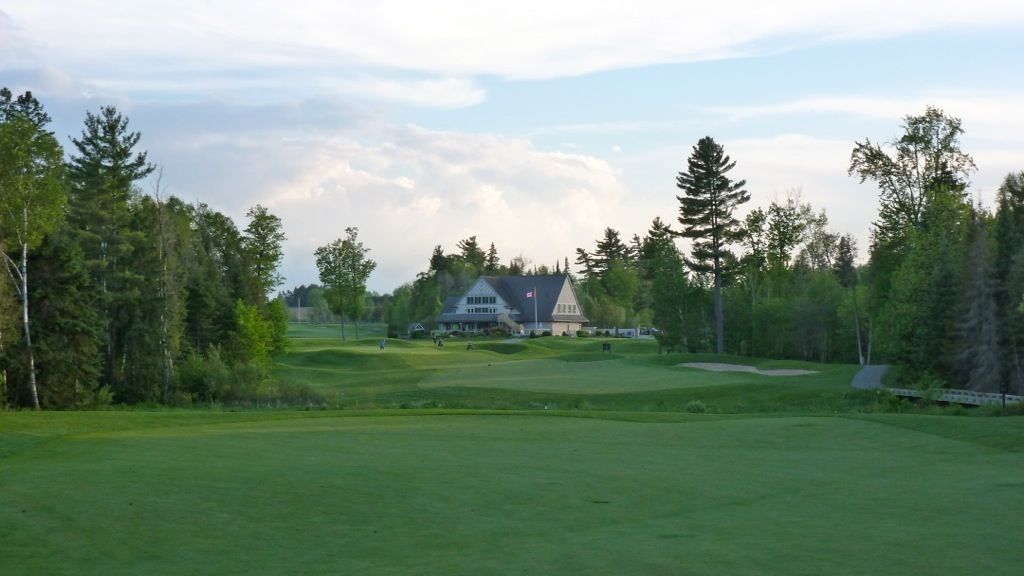
Another good green. Open in front and welcoming a running shot from the right but allowing for little room for error. Shots missing right will find an out-of-place looking pot bunker and shots missing left will kick down into an area well below the putting surface.

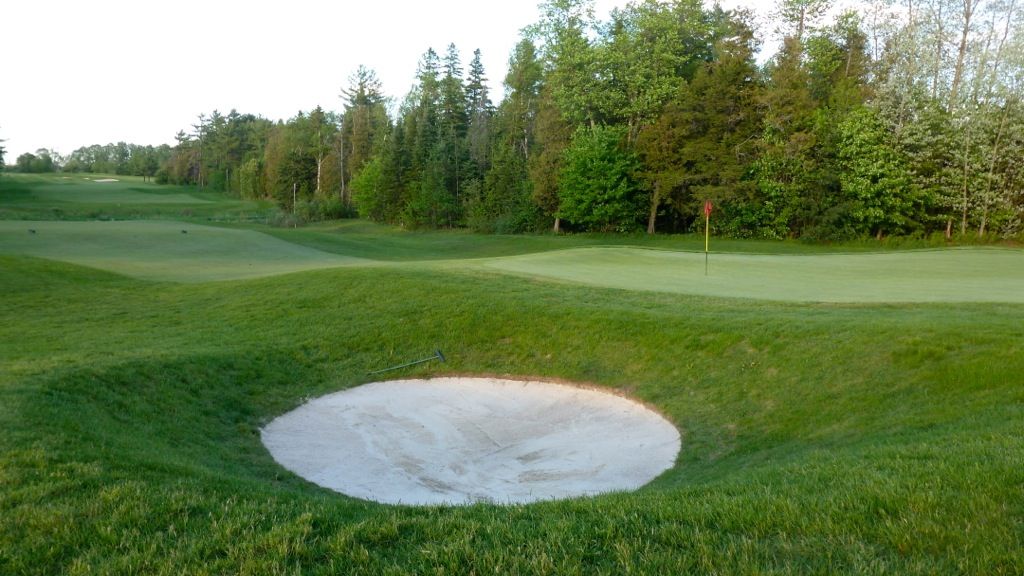
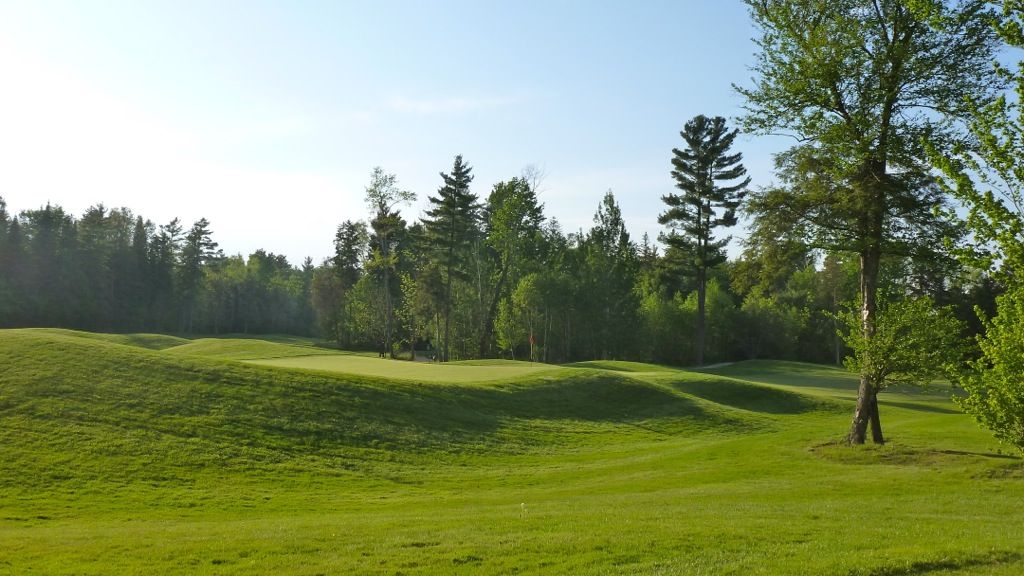
The green lay at an angle to fairway and is split (yet again) by a diagonal ridge across its centre.


Hole 10: Par 5, 489 Yards -- The 9th played downhill, the 10th plays back up the same hill. Both 9 and 10 are birdie holes, though the 9th carries the greater risk of bogey+. Put me in the camp that thinks that first bunker on the right adds little. I think a centreline feature would have worked really well on this short par-5, especially with the green orientation.
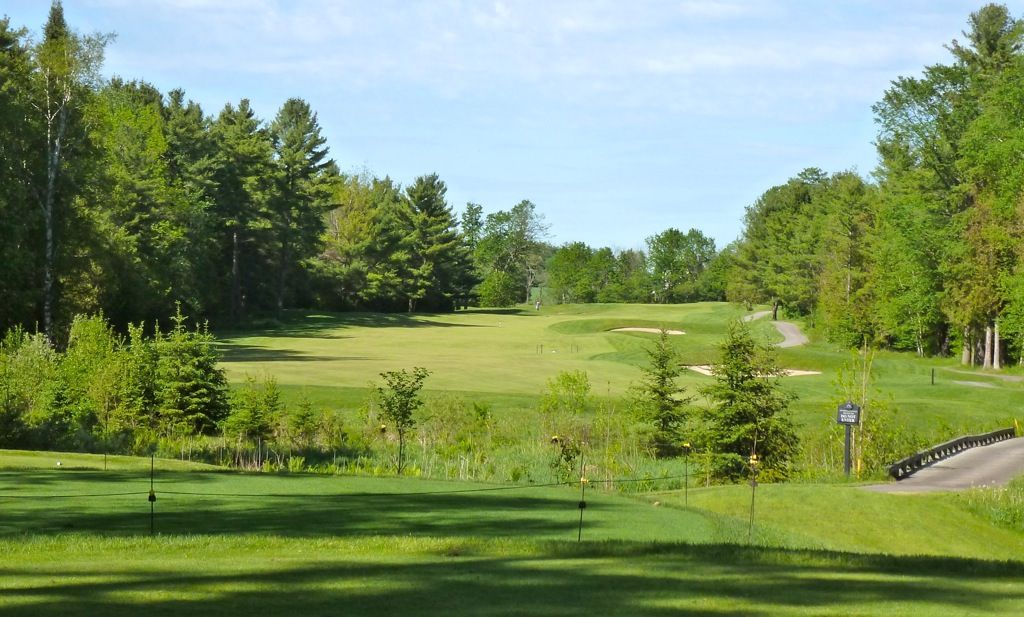
For those not going for the green in two, the second shot is a boring one.
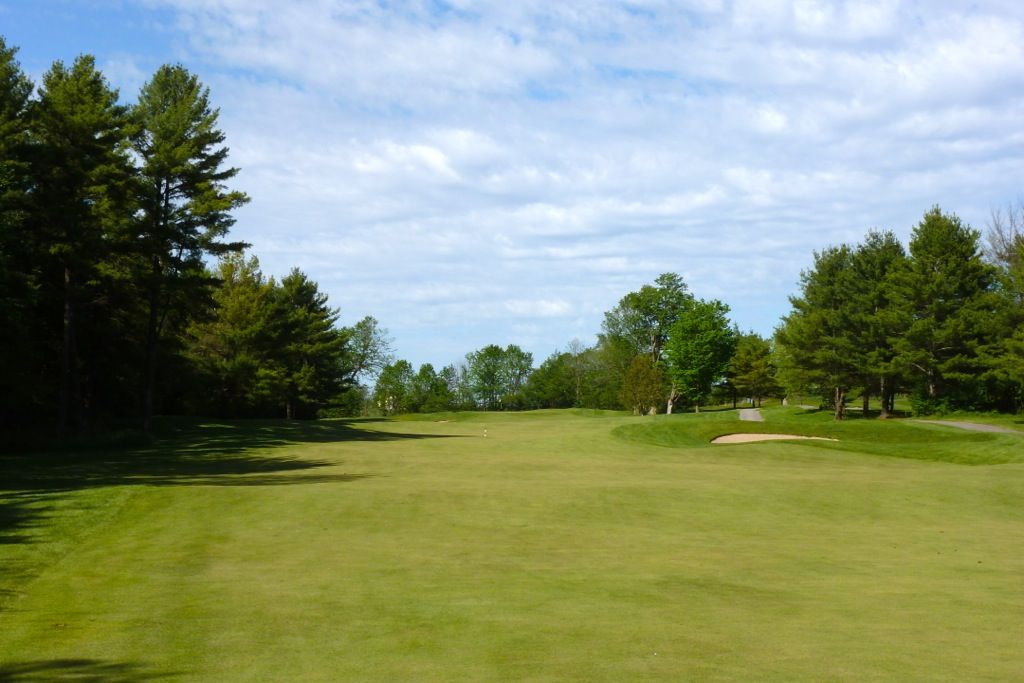
The approach to the green gives no indication of the shape/size of the green (which is another good one!). Deep bunkers left have many golfers pushing their approaches right, but recovery from there is near impossible.
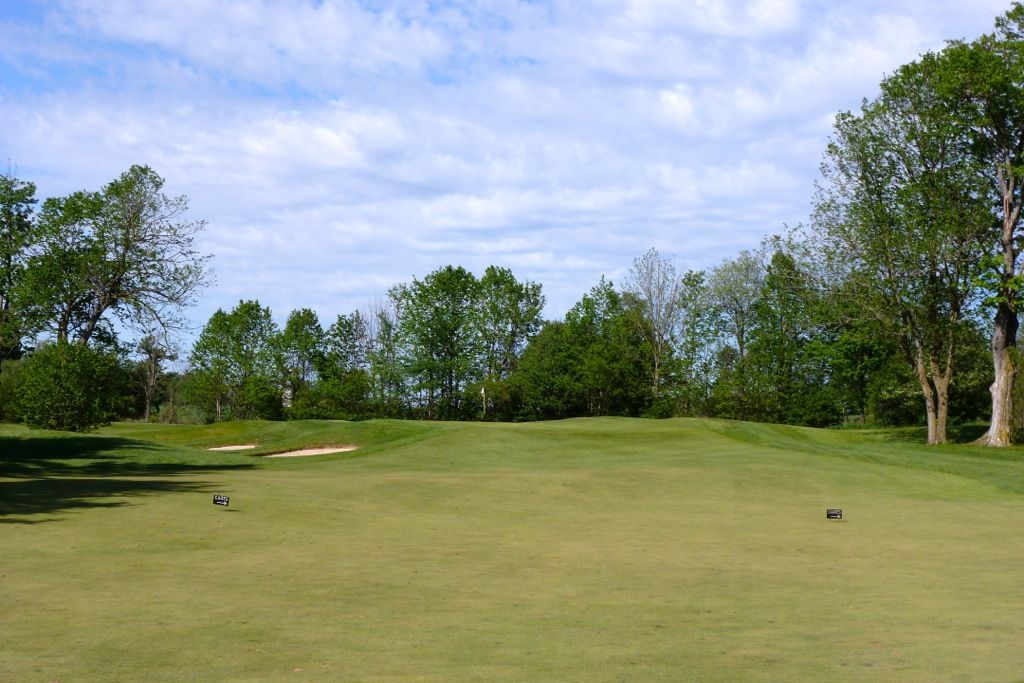
Two large humps extending from the right edge of the green to its centre dictate play. Fortunately, the green counterslopes at the left edge allowing recoveries from right of the green to remain on the putting surface.
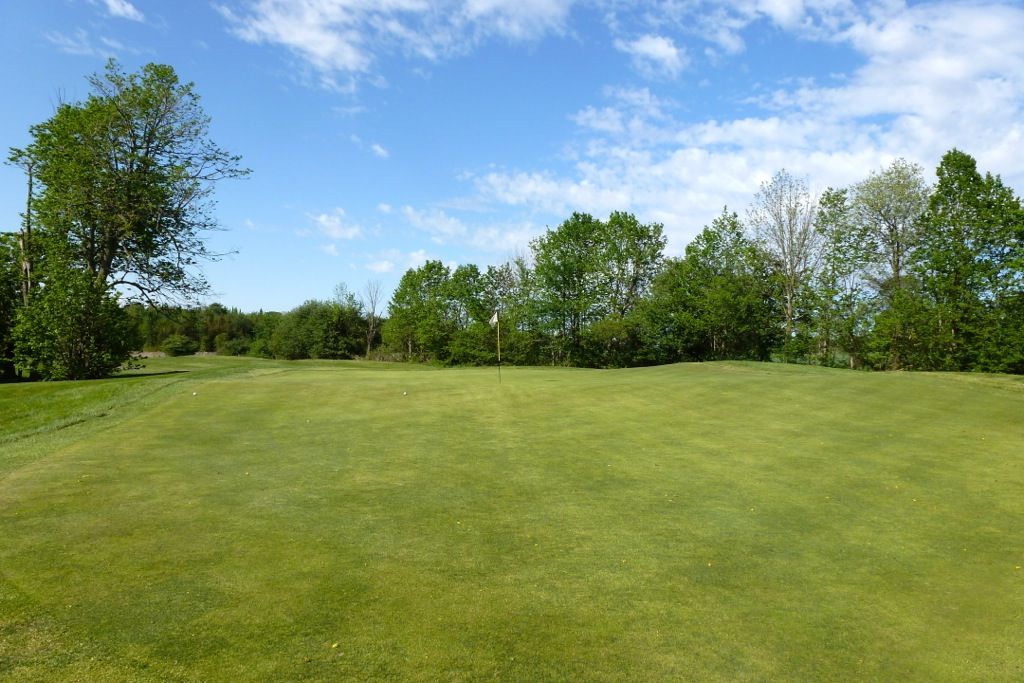

Hole 11: Par 4, 393 Yards -- Another strong and clever par-4. The tee shot is played downhill to a fairway that is partially hidden by a grass bunker 190 yards from the tee. A rare example of excellent mowing lines, the fairway widens to the right over the grass bunker and opens up the ideal angle into the 11th green.
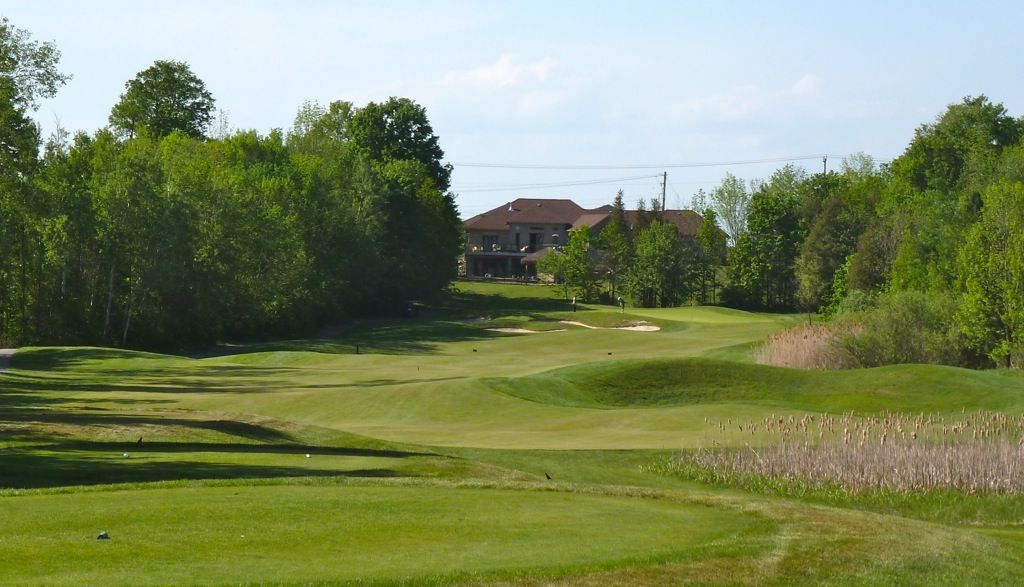
Golfers must choose whether to lay-back to the width of the fairway, about 240 yards from the tee, or whether to challenge the hazard that runs along the right side from just inside the 150-yard marker:
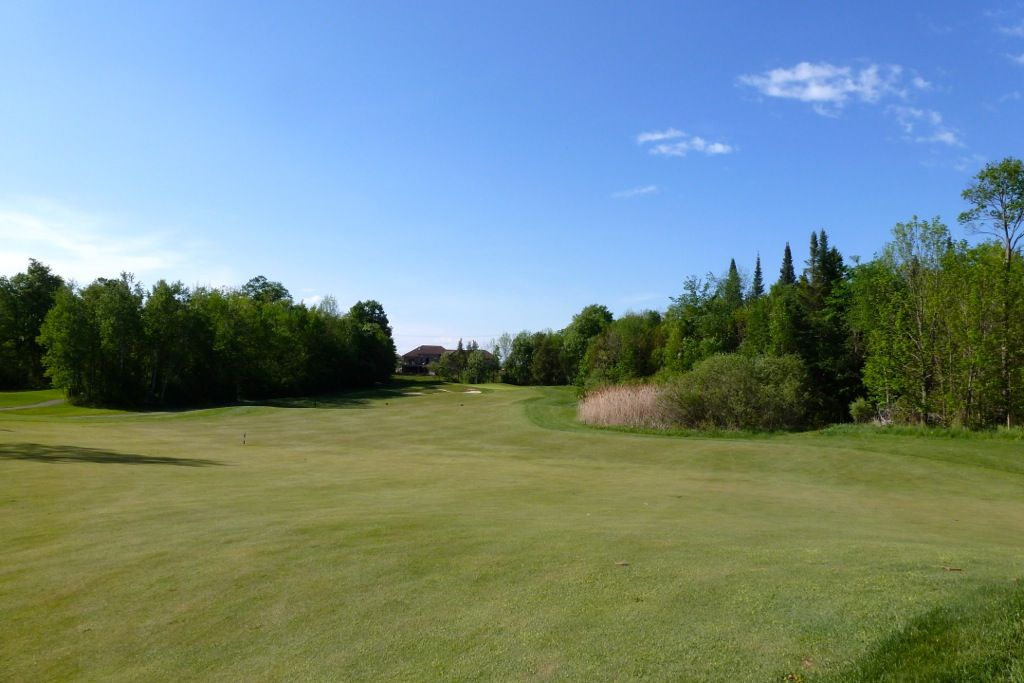
The green again lay at angle to the fairway and only the right portion of the green is visible from the fairway. Approaching the green from the right is preferred, especially to a left pin position.
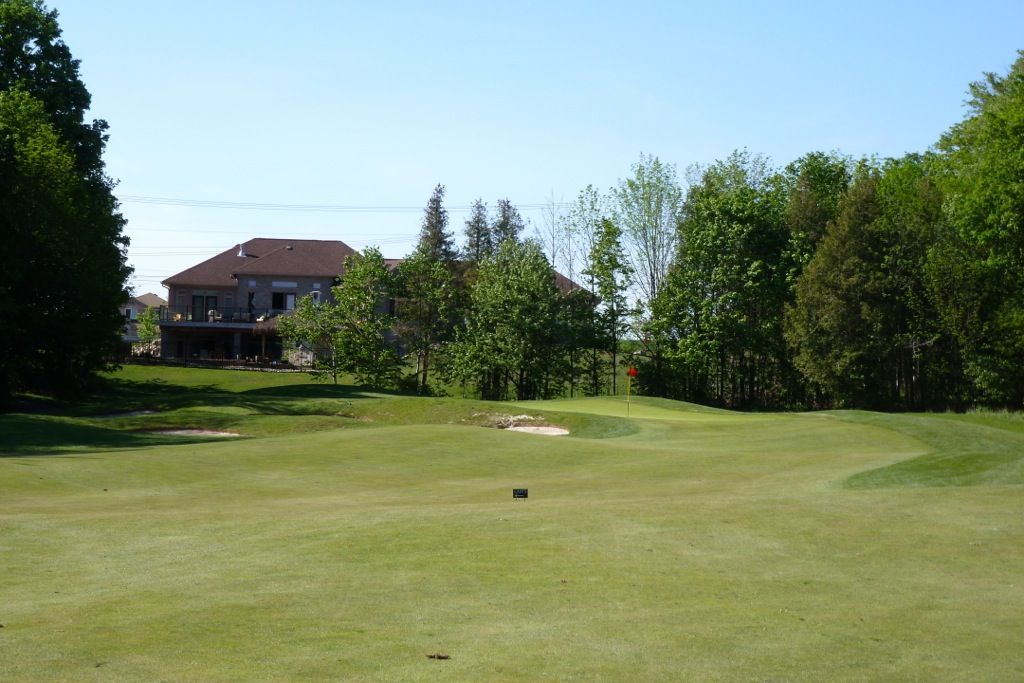
Something that become something of a McBroom trademark (and something that I hate!) is the overuse of 'short' greenside bunkers. The 11th at National Pines is another example...
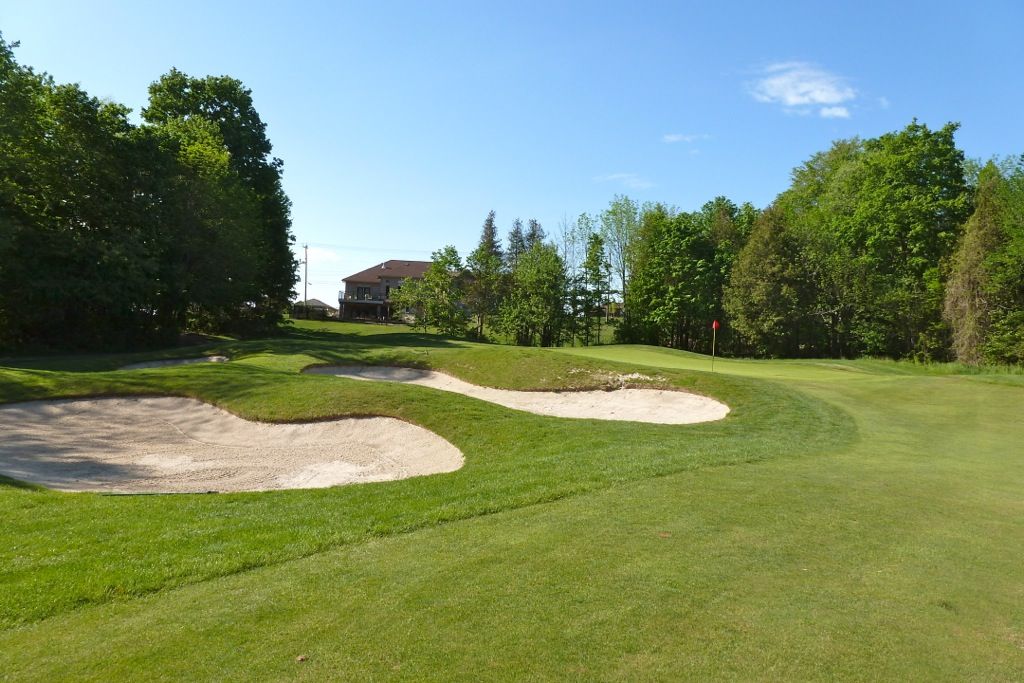
The entire green slopes significantly from back-to-front and a spine splits the green left and right
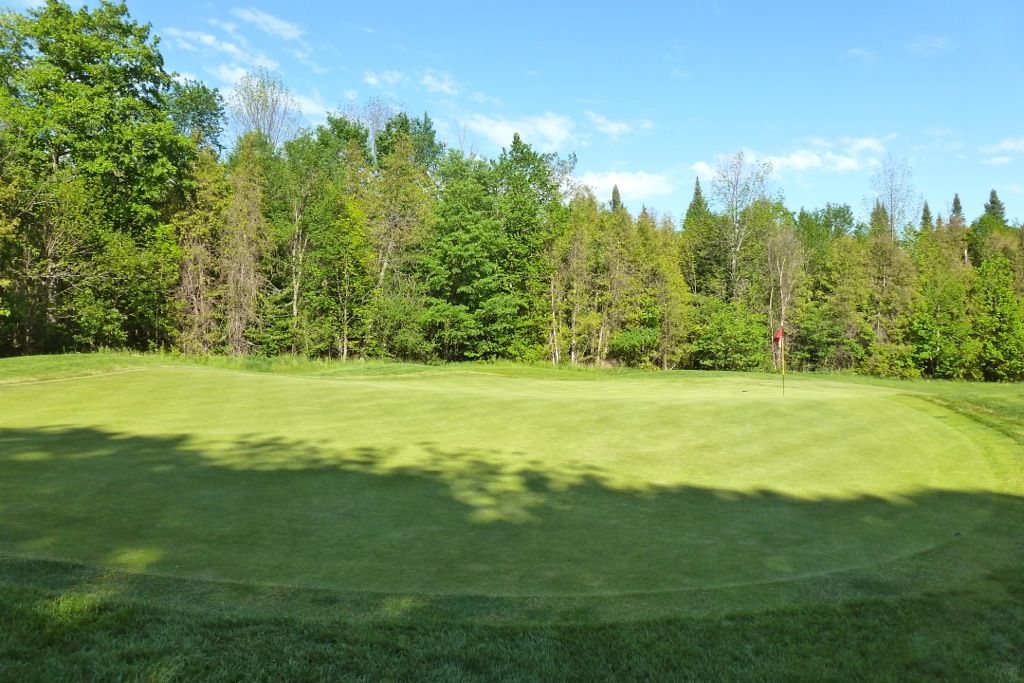
Hole 12: Par 4, 394 Yards -- The 12th runs alongside the 11th, though it is not blessed with the same interesting terrain. The tee shot is a lay-up for many as the fairway narrows significantly around the 150 yard marker. Those wishing to leave a shorter approach must thread the needle to find a fairway protected by 2 bunkers left and 1 right.
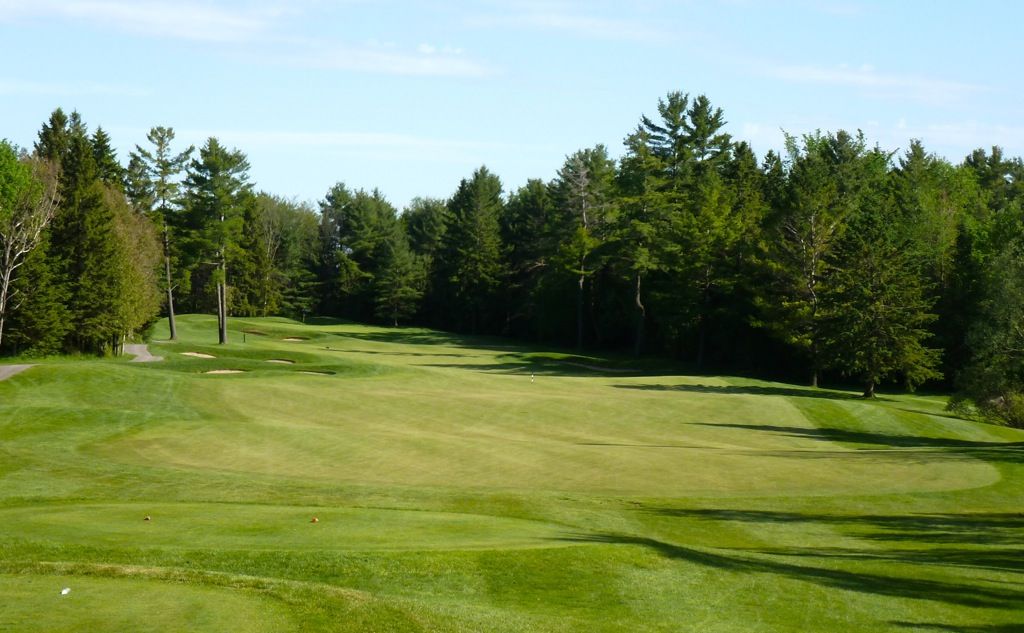
The approach to the 12th is a straightforward one, though a deep bunker short-left of the green and a fairway cut run-off on the right do complicate the matter slightly.
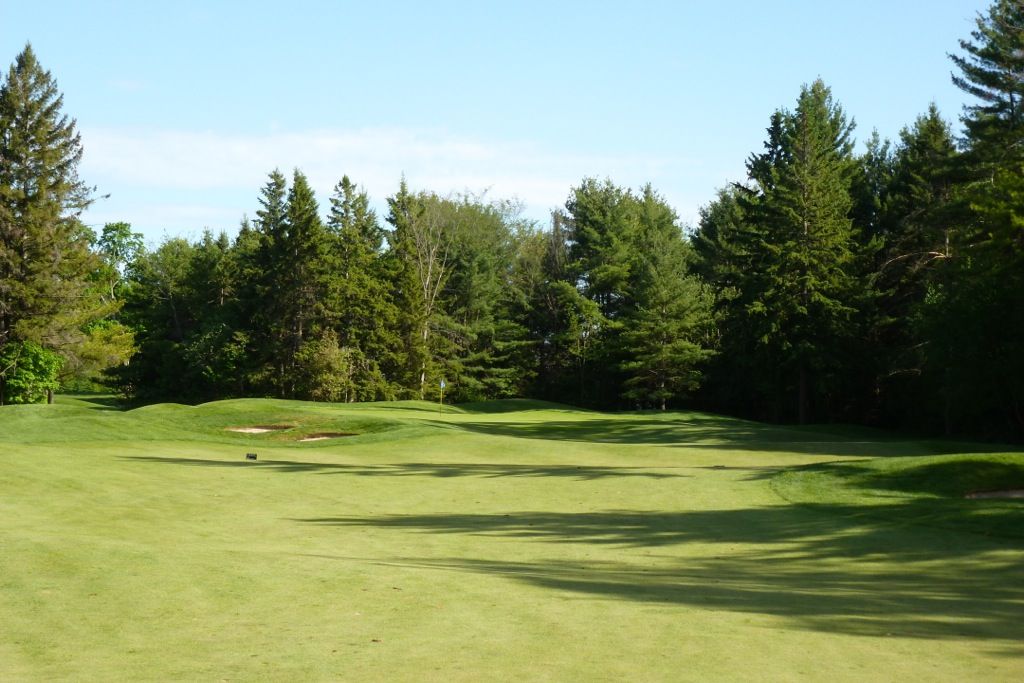
Hole 13: Par 3, 180 Yards -- The most difficult of a strong set of par-3s at National Pines. Once again the tee shot calls for a forced carry over wetlands (should not be in play) and a series of bunkers to reach the extremely contoured putting surface. In my opinion, McBroom erred in building this hole the length he did. With such a small, segmented green, and given that there is no short par-3 on the course, I think this hole would be better suited playing well under 150 yards.

The 13th green is a wild one. A small front-right portion of the green tilts hard toward the tee. Left of this portion is a steep spine. Left of the spine the green again slopes significantly toward the front though there is a near impossible to hit back shelf that can't be more than 15 feet deep.

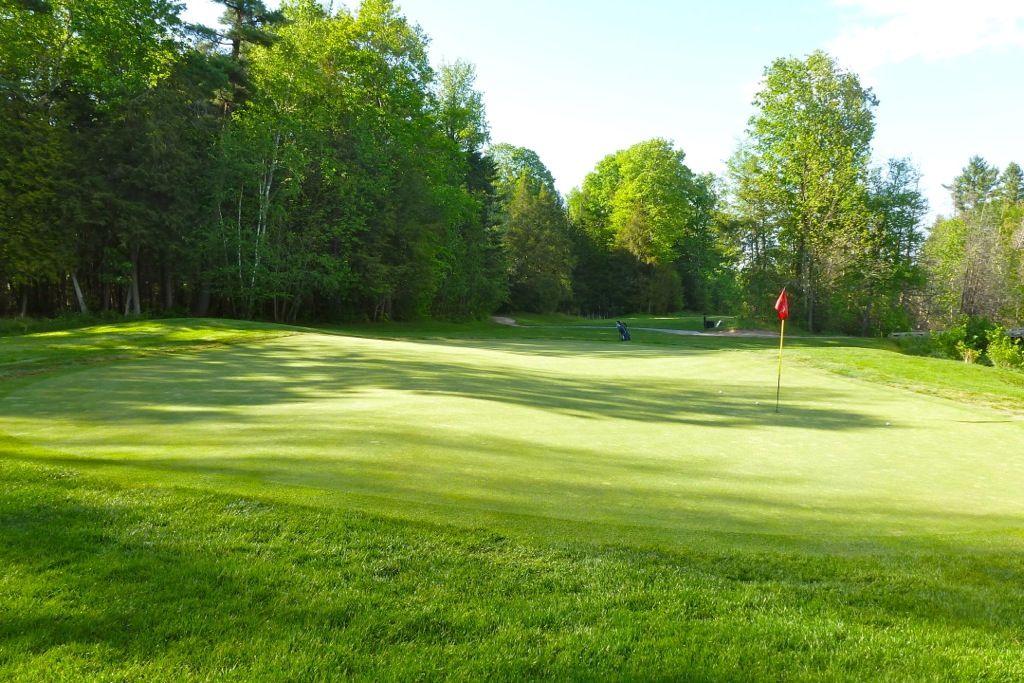
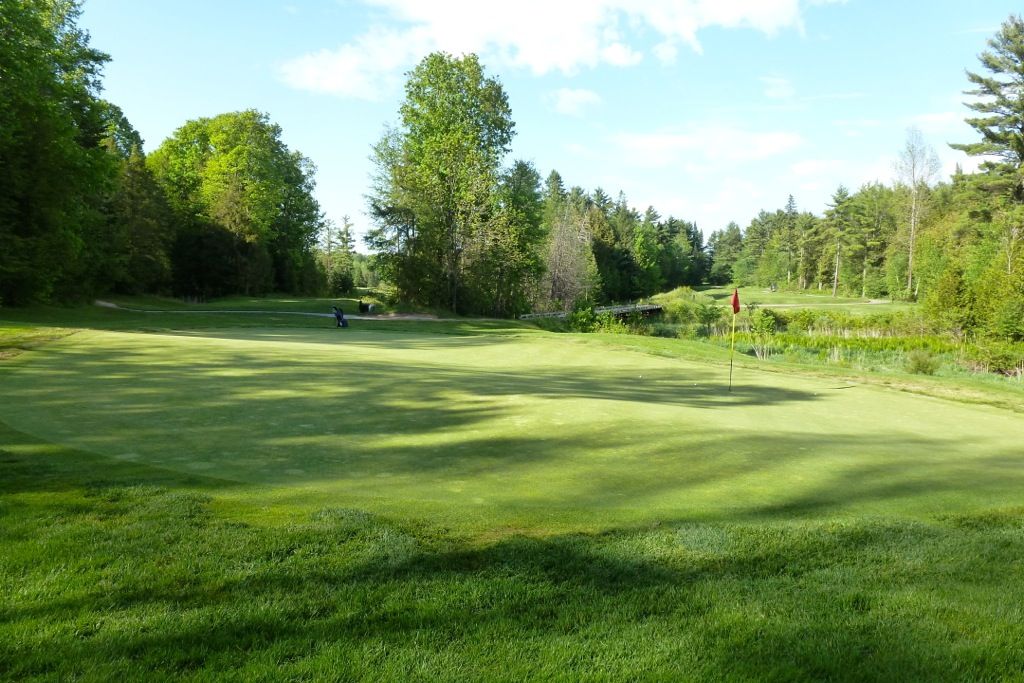
Hole 14: Par 5, 545 Yards -- The only true 3-shot par-5 at National Pines, the 14th calls for a draw off the tee, over the edge of the bunkers guarding the fairway. Perhaps an overly penal tee shot, the fairway is guarded left by bunkers and right by woods and the widest part of the fairway can only reached by the longer hitters. Not surprisingly, mowing lines are an issue as a bold tee shot over the left side of the bunkers will leave the golfer in the rough, and possibly blocked-out.
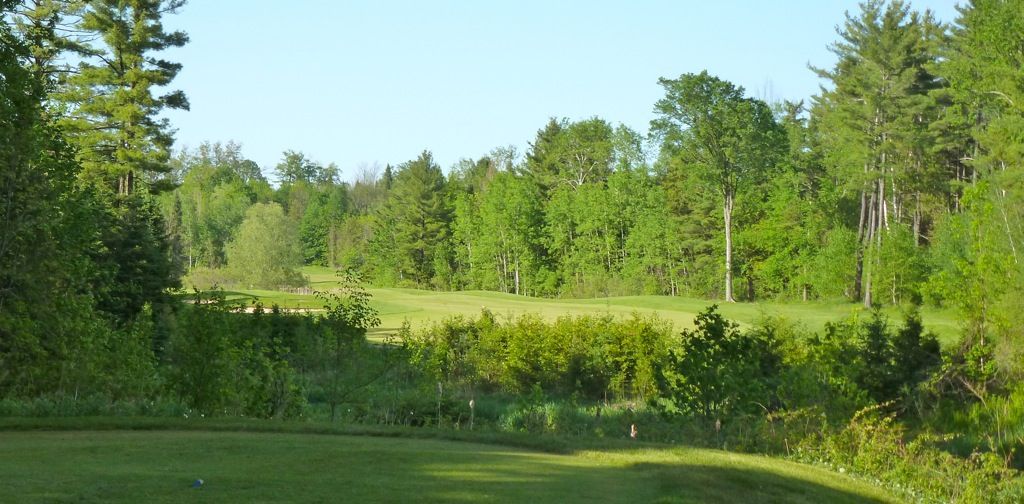
Some say that the second shot on a par-5 is most often the most boring shot in golf. I think McBroom has cleverly guarded the lay-up zone to ensure that one most think his way to the green. The fairway is wide at the 150 yard marker, but narrows significantly just past that as a bunker juts into the fairway from the left. Once over the bunker the fairway once again widens until 80 yards short of the green.
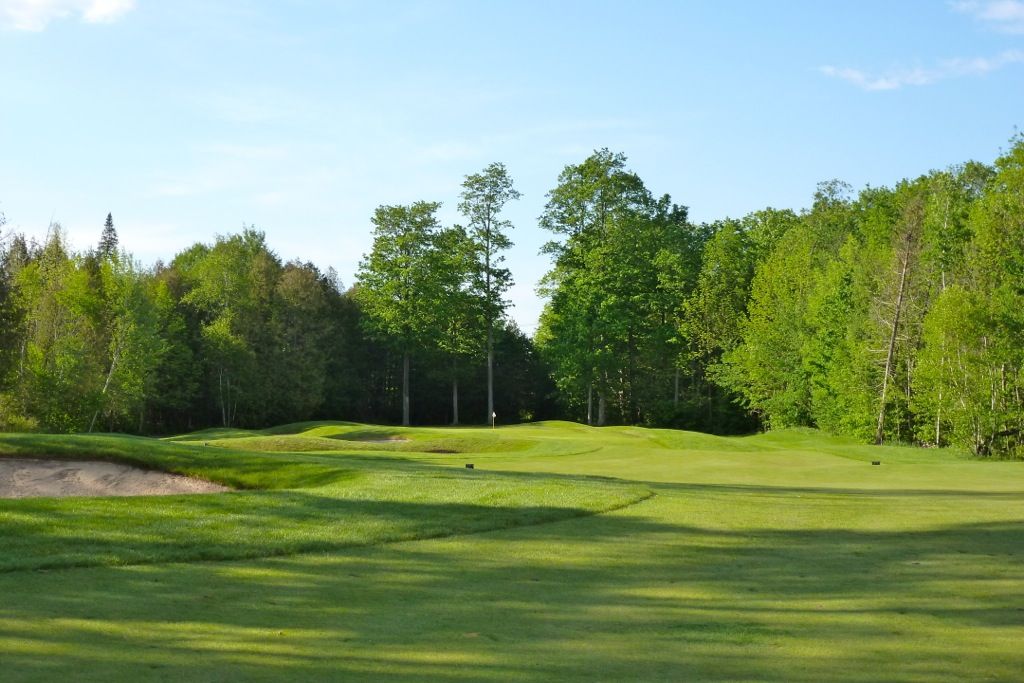
Though I didn't know its name for years, I now know the 14th green is a version of the Biarritz, with shelves front and back and a deep swale running across its centre.

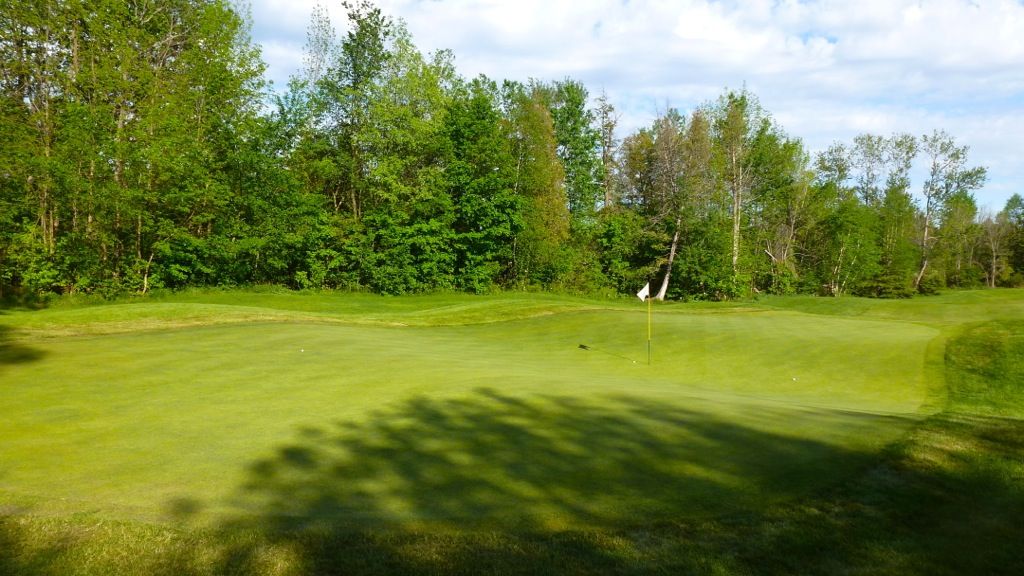
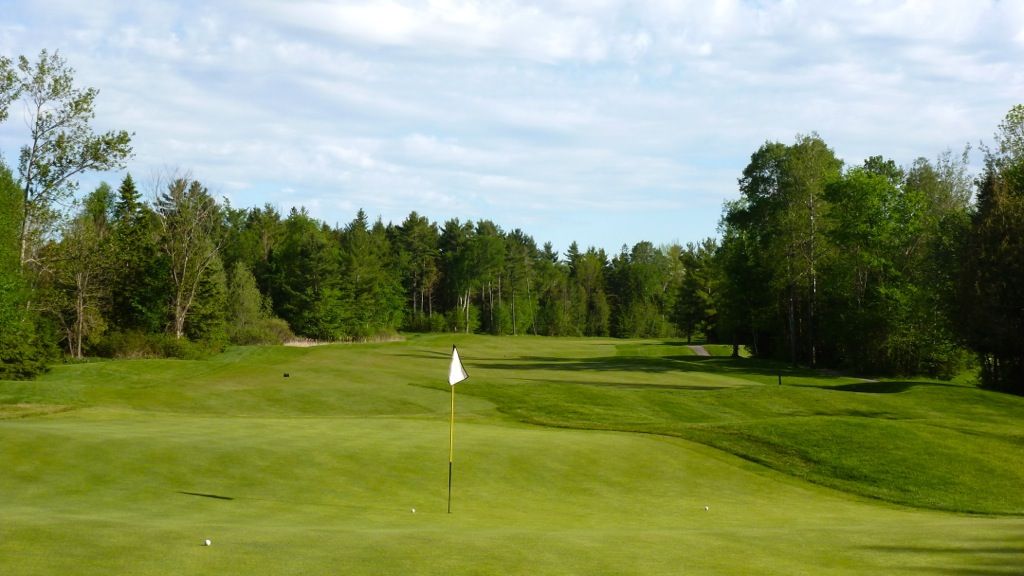
Hole 15: Par 4, 351 Yards -- Easily the most controversial hole at National Pines. I think the hole is well-conceived though poorly executed. The hole features a split fairway; the left fairway requires no forced carry but leaves a very difficult angle into the green, while the right fairway requires an all-or-nothing carry of 210 yards over wetlands, but if successful leaves a simple pitch into the green.
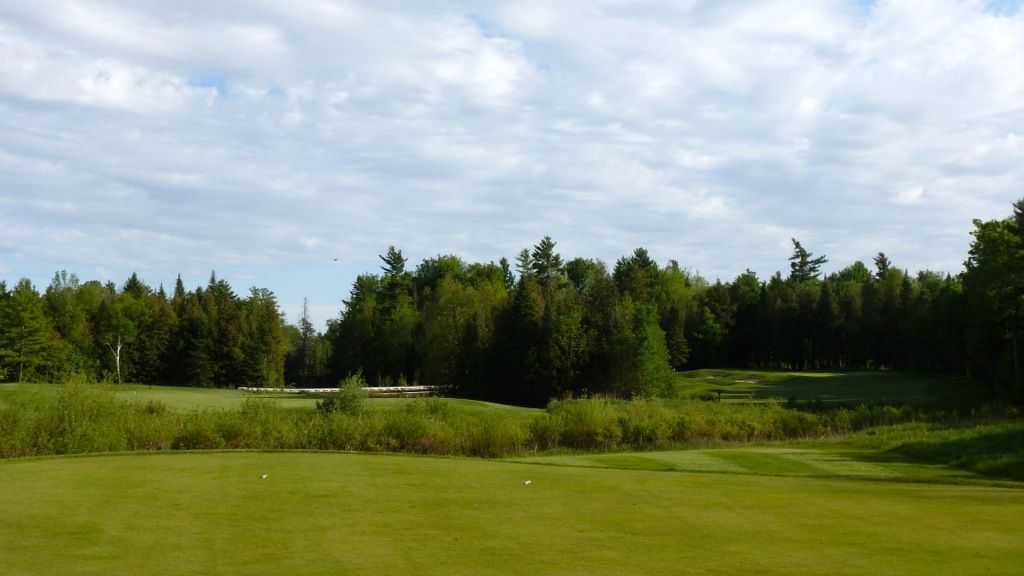
A closer look at the left fairway. The major fault with the hole (difficulty in walking to the right fairway aside) is that the left fairway requires to long a tee shot to leave a clear view of the green. A grouping of trees in the hazard run along the right side of the left fairway and a tee shot under 200 yards will be completely blocked-out, leaving no shot but a sideways chip. If a golfer cannot make the 210 yard carry, should he be required to play a tee shot of greater than 200 yards on the lay-up route? I don't think so.
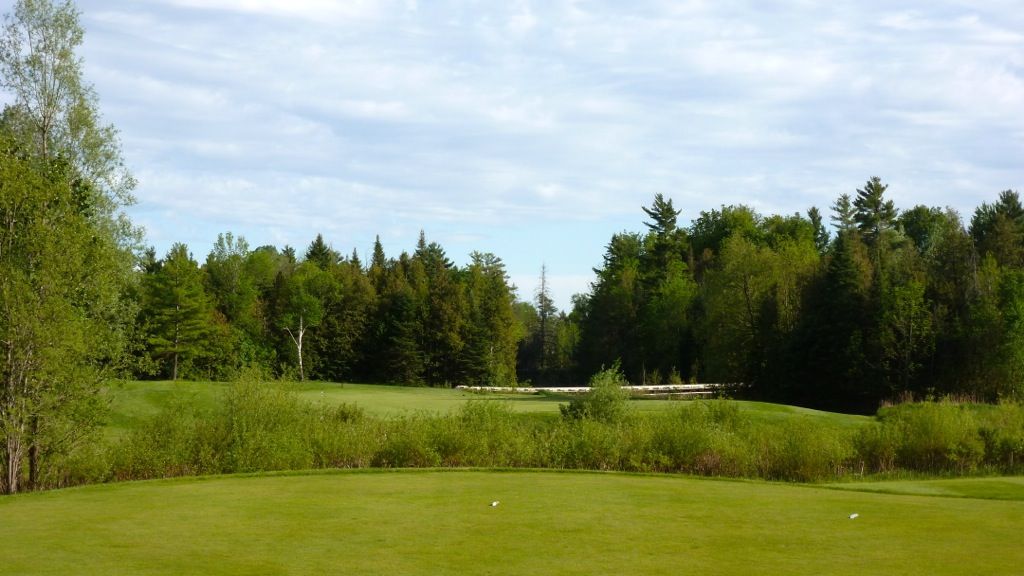
Close-up of the right fairway. The shortest line over the hazard is along the right edge of the fairway, and the angle into the green from this side is ideal.

If the golfer successfully finds the left fairway, he is left with an extremely difficult approach over mounding and bunkers and a green lay at a 45 degree angle. I've seen very few approaches find the green from the left fairway.
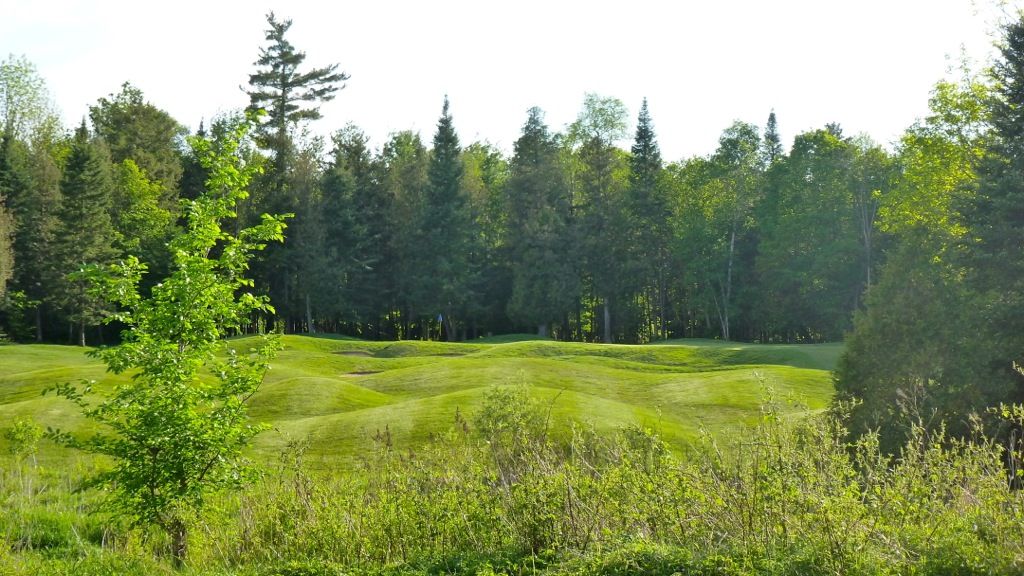
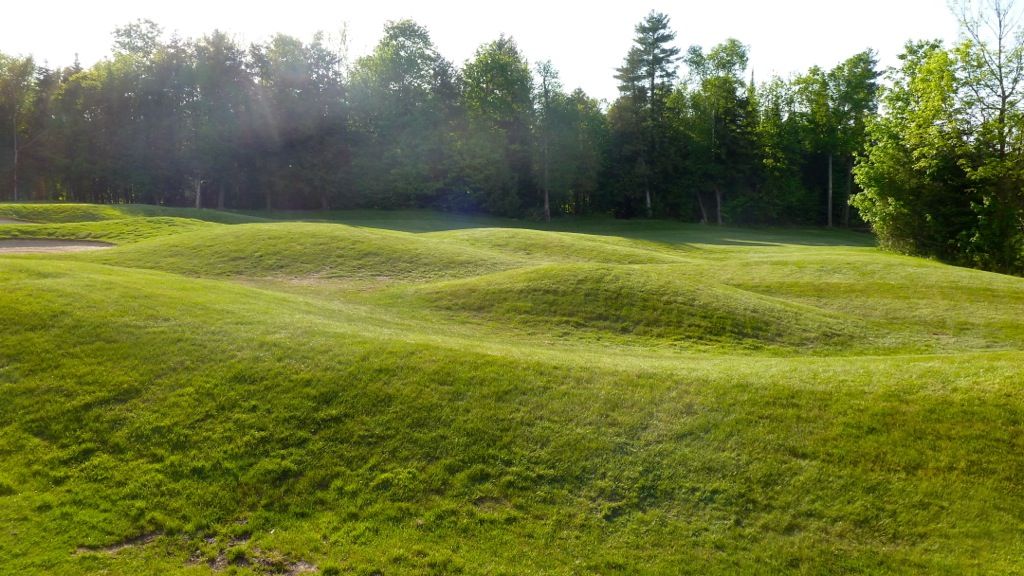
The approach from the right fairway is a simple one, even if much of the green's surface is blind.
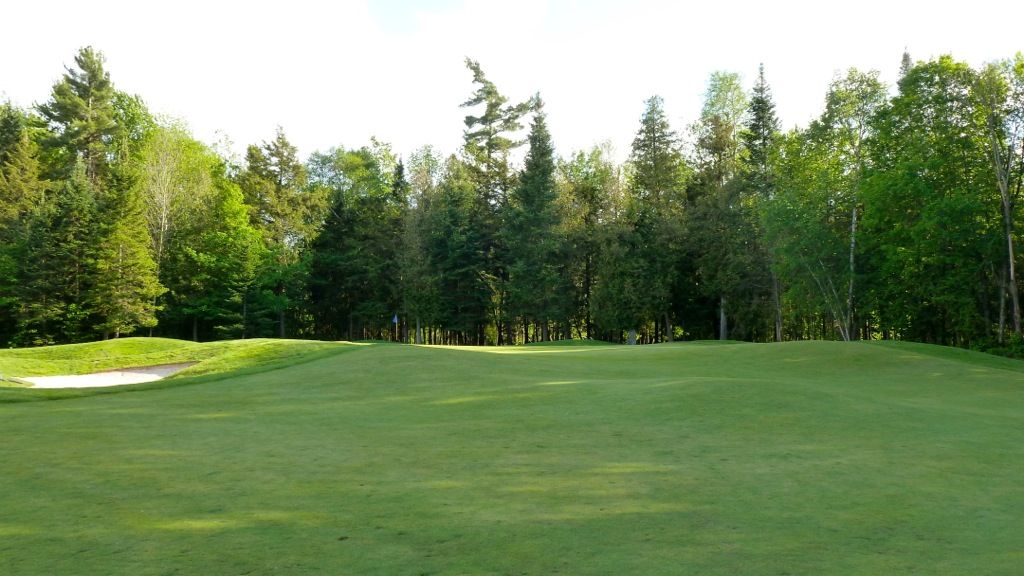
Another wildly contoured green with a very tilted front portion, and two diagonal ridges creating middle and back sections.
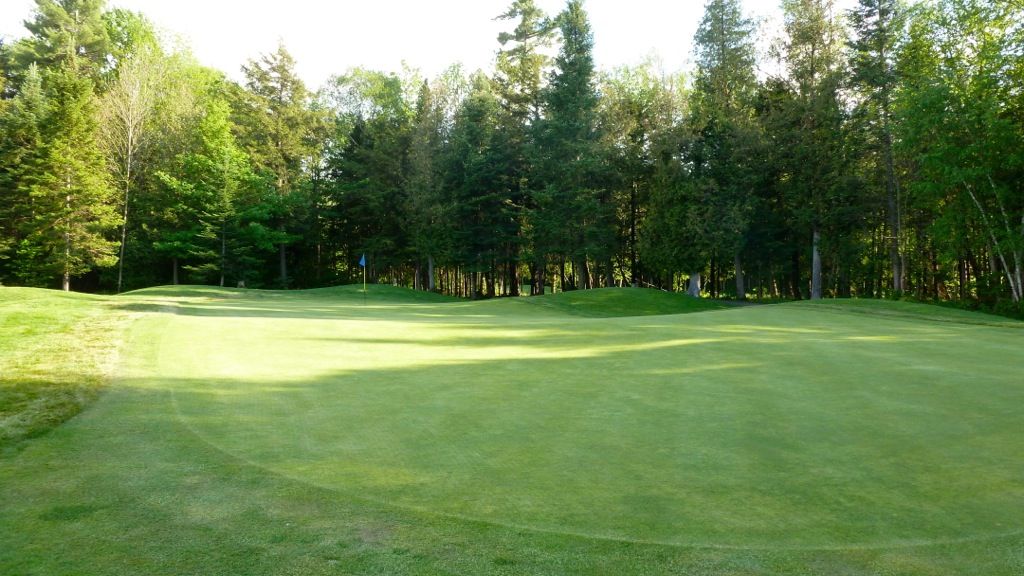

Hole 16: Par 3, 168 Yards -- A green in an idyllic setting, over a stream and set in an amphitheatre of trees. Unfortunately, getting to and from the green requires an interruption in the routing. The green is a tiny target, though fortunately the traditional righty misses will not hurt because of the angle of the green.
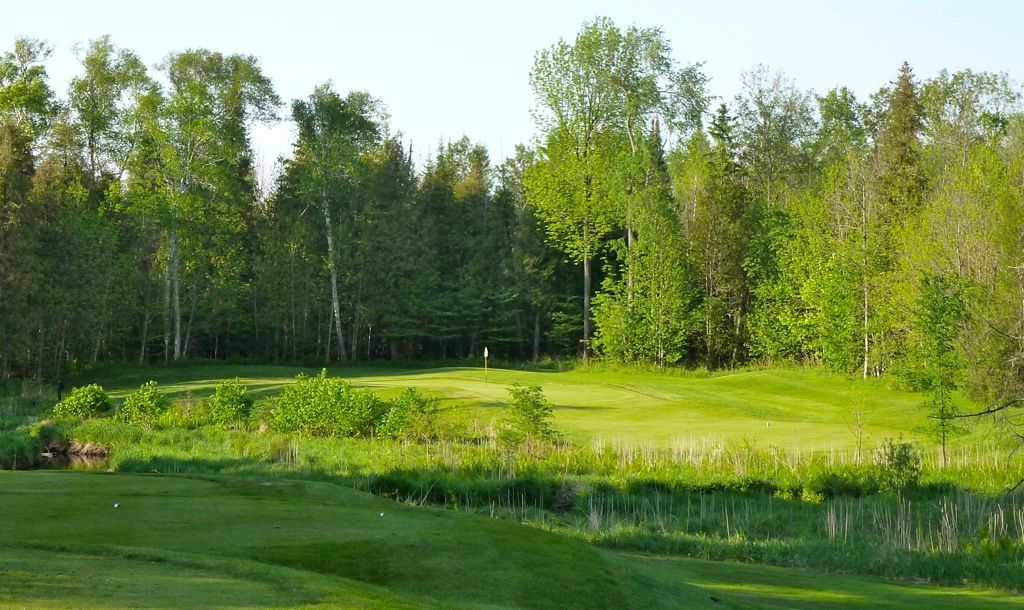

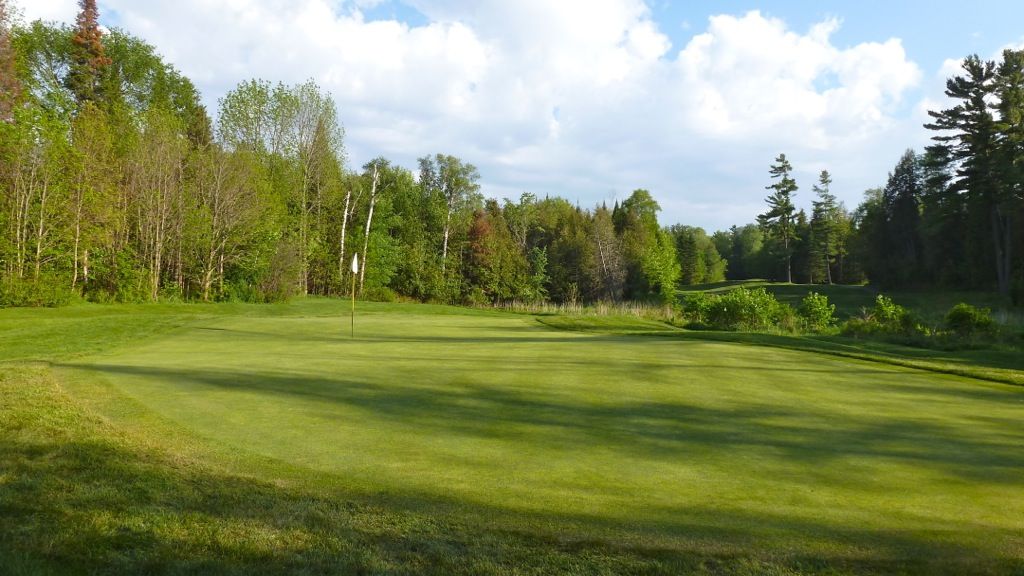
Hole 17: Par 4, 390 Yards -- Arguably the prettiest hole on the golf course, a dogleg left whose tee shot angle gets increasingly difficult as the golfer moves back in tees. The ideal line is from the left side of the fairway over the fairway bunkers, though the mowing lines are an issue here (seem arbitrary to me) and tee shots over the left side of the bunkers will find rough and an awkward lie.
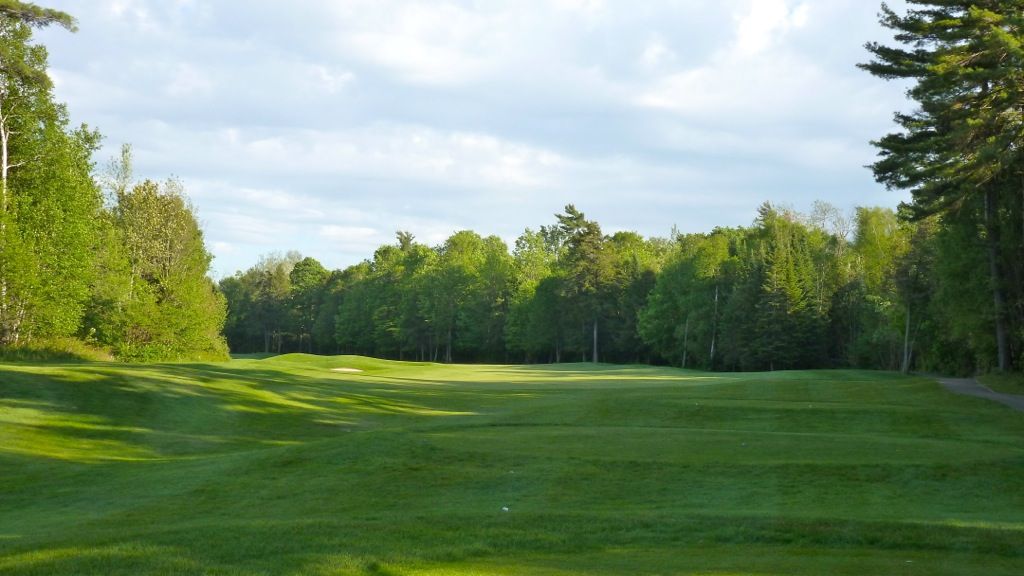
Approach from the left saves the golfer from the visually obtrusive fairway bunker short of the green and also allow the golfer to play an approach into the green's tilt.
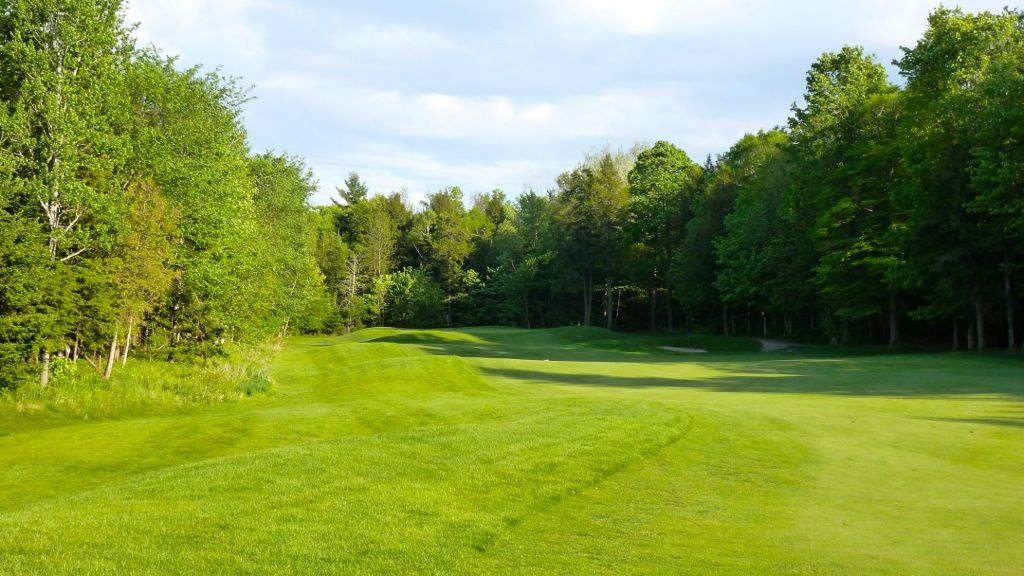
The green slopes from right to left and is split front and back by a ridge across its centre.
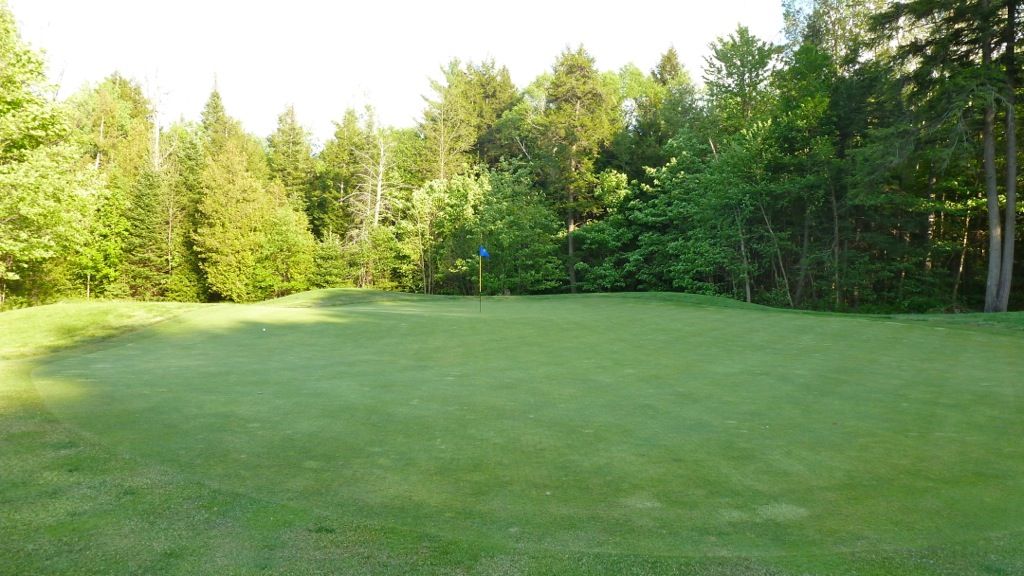
Hole 18: Par 4, 401 Yards -- If there is a flaw in the closing duo of par-4s, it is that each is of similar length, of similar shape, and play in the same direction. Still, like the 17th, the 18th is a strong hole. The single fairway bunker is little more than an aiming bunker for most, at a little over 250 yards to reach. Some (like me) will choose to hit less than driver to play to the width of the fairway short of the bunker.
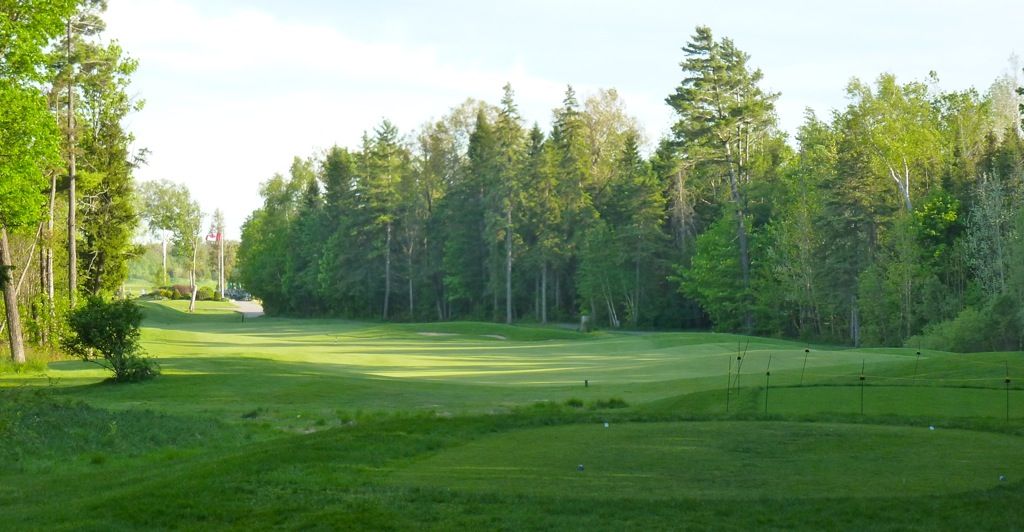
The approach can be run onto the green, though most will probably choose an aerial approach to carry the fronting upslope.
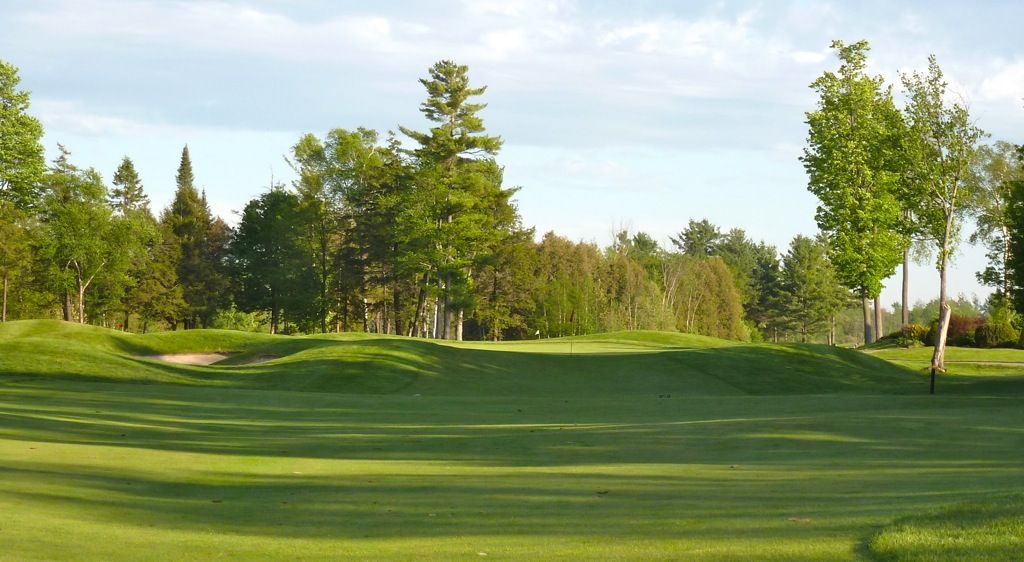
Something of a departure from the majority of the greens at National Pines, the 18th green is simple in contour, using a single broad contour on its right side and a back-to-front tilt to create interest.
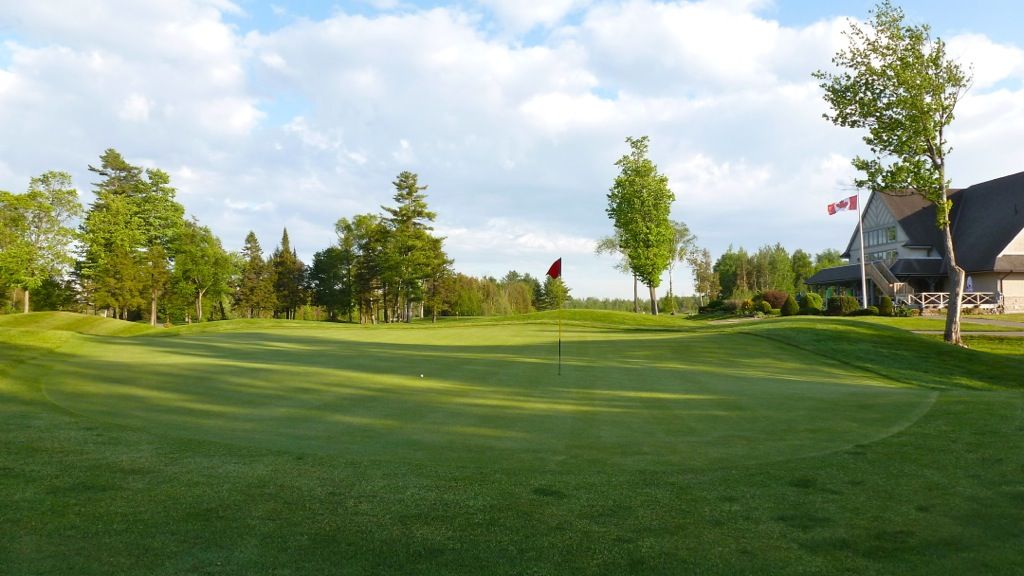
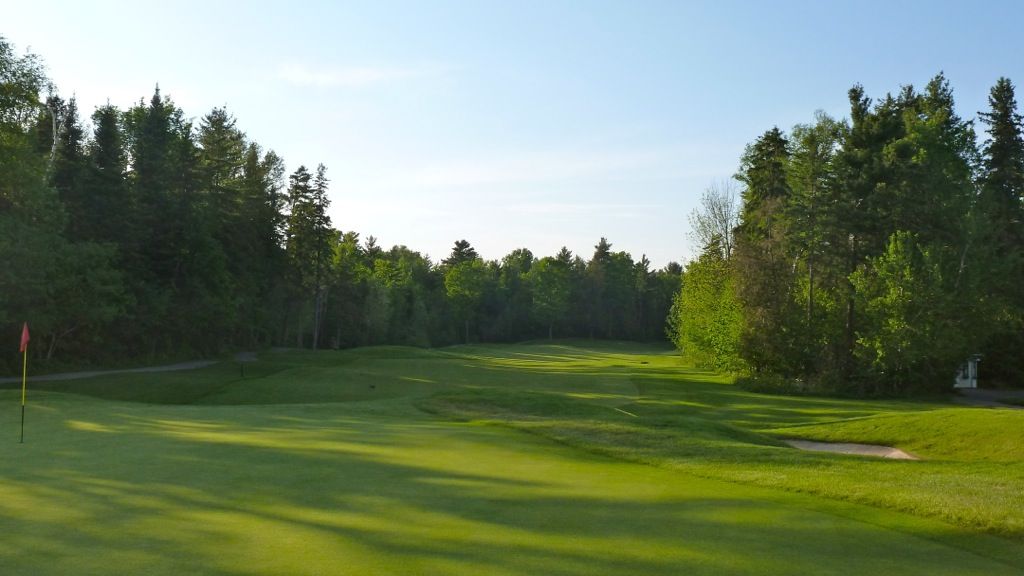

Interesting golf course!!! Will play there soon!!!
ReplyDeleteThanks for those clear description and pictures!!!